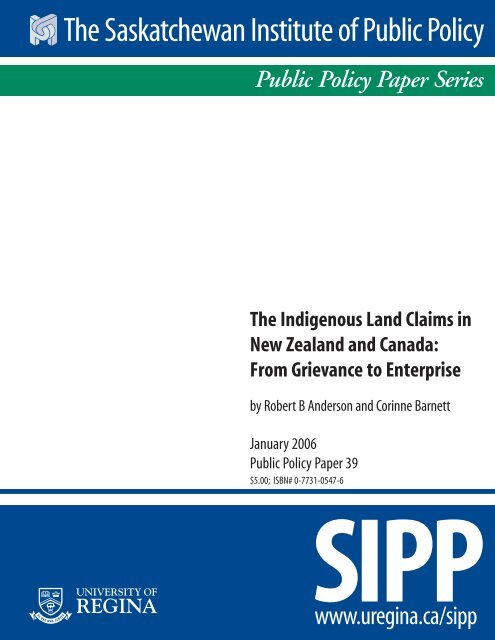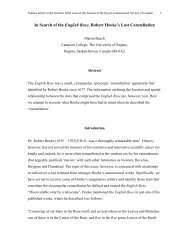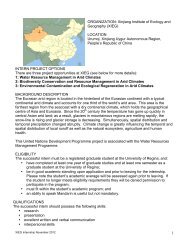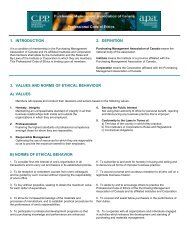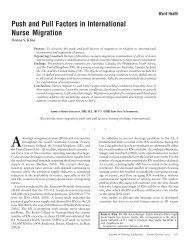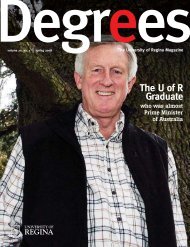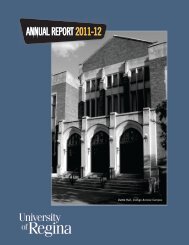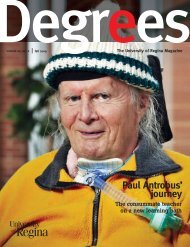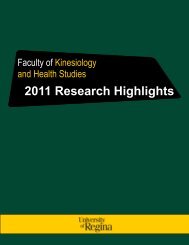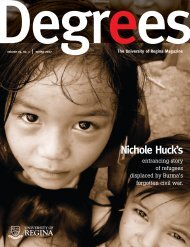The Indigenous Land Claims in New Zealand and Canada
The Indigenous Land Claims in New Zealand and Canada
The Indigenous Land Claims in New Zealand and Canada
Create successful ePaper yourself
Turn your PDF publications into a flip-book with our unique Google optimized e-Paper software.
<strong>The</strong> Saskatchewan Institute of Public PolicyPublic Policy Paper Series<strong>The</strong> <strong>Indigenous</strong> <strong>L<strong>and</strong></strong> <strong>Claims</strong> <strong>in</strong><strong>New</strong> <strong>Zeal<strong>and</strong></strong> <strong>and</strong> <strong>Canada</strong>:From Grievance to Enterpriseby Robert B Anderson <strong>and</strong> Cor<strong>in</strong>ne BarnettJanuary 2006Public Policy Paper 39$5.00; ISBN# 0-7731-0547-6SIPPwww.ureg<strong>in</strong>a.ca/sipp
<strong>Indigenous</strong> <strong>L<strong>and</strong></strong> <strong>Claims</strong> <strong>in</strong> <strong>New</strong> <strong>Zeal<strong>and</strong></strong> <strong>and</strong> <strong>Canada</strong>:From Grievance to EnterpriseSIPP Public Policy Paper No. 39January 2006Robert B Anderson <strong>and</strong> Cor<strong>in</strong>ne BarnettISBN# 0-7731-0547-6ISSN# 1702-7802
This paper explores the struggle by <strong>Indigenous</strong> people <strong>in</strong> <strong>Canada</strong> <strong>and</strong> <strong>New</strong> <strong>Zeal<strong>and</strong></strong> 1 forthe recognition of their rights to their traditional l<strong>and</strong>s <strong>and</strong> resources <strong>and</strong> the role that theseresources are expected to play, <strong>and</strong> <strong>in</strong>deed have played, <strong>in</strong> provid<strong>in</strong>g Aborig<strong>in</strong>al people <strong>and</strong> Maorithe capacity to pursue development on their terms both economically <strong>and</strong> as ‘nations’ with<strong>Canada</strong> <strong>and</strong> <strong>New</strong> <strong>Zeal<strong>and</strong></strong>.While we focus on these two groups, it is important to emphasize that the issue of <strong>Indigenous</strong>l<strong>and</strong> rights <strong>and</strong> development are not just important <strong>in</strong> <strong>Canada</strong> <strong>and</strong> <strong>New</strong> <strong>Zeal<strong>and</strong></strong>. <strong>The</strong> United Nationsestimates that approximately 5,000 groups fit its def<strong>in</strong>ition of <strong>Indigenous</strong> <strong>and</strong> that there are between300 million to 500 million <strong>Indigenous</strong> peoples worldwide represent<strong>in</strong>g as much as 80% of the culturaldiversity on this planet (<strong>Indigenous</strong> Peoples’ Human Rights Project, 2003). <strong>The</strong> list of nation stateswithout an <strong>Indigenous</strong> population is very small. Further, accord<strong>in</strong>g to the World Bank “<strong>Indigenous</strong>peoples are commonly among the poorest <strong>and</strong> most vulnerable segments of society” (World Bank,2001). Wherever they are found, <strong>Indigenous</strong> peoples are engaged <strong>in</strong> a struggle to preserve theirsocieties, reta<strong>in</strong> or rega<strong>in</strong> their rights, improve their socio-economic conditions <strong>and</strong> rebuild theirnations on their terms. <strong>L<strong>and</strong></strong> rights are critical <strong>in</strong> every <strong>in</strong>stance <strong>in</strong> this effort. How much better for all,<strong>Indigenous</strong> <strong>and</strong> non-<strong>Indigenous</strong>, if states follow the path grudg<strong>in</strong>gly trod by <strong>Canada</strong> <strong>and</strong> <strong>New</strong> <strong>Zeal<strong>and</strong></strong>that we describe <strong>in</strong> this paper <strong>and</strong> negotiate the settlement of l<strong>and</strong> rights claims as part of a strategy tosupport <strong>Indigenous</strong> communities <strong>in</strong> their pursuit of development as they def<strong>in</strong>e it; rather than pursu<strong>in</strong>gthe more commonly followed alternative of the refusal to recognize <strong>Indigenous</strong> rights, oppression <strong>and</strong>poverty.1 Aborig<strong>in</strong>al peoples is the general <strong>in</strong>clusive term used when referr<strong>in</strong>g to the <strong>Indigenous</strong> people <strong>in</strong> <strong>Canada</strong>. Included under the termAborig<strong>in</strong>al people are the First Nations, the Métis <strong>and</strong> the Inuit populations <strong>in</strong> <strong>Canada</strong> as recognized <strong>in</strong> the Constitution Act, 1982.<strong>The</strong> Maori are the <strong>Indigenous</strong> people of <strong>New</strong> <strong>Zeal<strong>and</strong></strong>. We will use the word <strong>Indigenous</strong> as <strong>in</strong>clusive of both groups.1
We conduct our exploration <strong>in</strong> four sections. <strong>The</strong> first sets the context by describ<strong>in</strong>g thehistoric events <strong>in</strong> <strong>Canada</strong> <strong>and</strong> <strong>New</strong> <strong>Zeal<strong>and</strong></strong> that have resulted <strong>in</strong> the dem<strong>and</strong>s by <strong>Indigenous</strong>people for the recognition of their rights to l<strong>and</strong> <strong>and</strong> resources that have been long denied, <strong>and</strong> theresponse by the Canadian <strong>and</strong> <strong>New</strong> <strong>Zeal<strong>and</strong></strong> governments <strong>and</strong> courts to these dem<strong>and</strong>s. In thesecond section we present an overview of the current circumstance of Aborig<strong>in</strong>al people <strong>in</strong><strong>Canada</strong> <strong>and</strong> Maori <strong>in</strong> <strong>New</strong> <strong>Zeal<strong>and</strong></strong> <strong>and</strong> their response to these circumstance, which emphasizesdevelopment economically <strong>and</strong> ‘nationally’ on their own terms, with this development ground oncapacity provided by their traditional l<strong>and</strong>s <strong>and</strong> resources. We take the expressed developmentapproach <strong>and</strong> objectives as given both <strong>in</strong> this section <strong>and</strong> <strong>in</strong> the case studies. For us, success isachieved when the <strong>Indigenous</strong> group <strong>in</strong> question achieves its expressed objectives. In this paper, itis not our purpose or place to critique either the approach or the objectives.In the third section we present the cases which exam<strong>in</strong>e four l<strong>and</strong> claim agreements <strong>and</strong>the development efforts related to them. <strong>The</strong>se are the James Bay <strong>and</strong> Northern Quebec <strong>and</strong>Inuvialuit Agreements from <strong>Canada</strong> <strong>and</strong> the Ta<strong>in</strong>ui <strong>and</strong> Ngai Tahu Agreements from <strong>New</strong><strong>Zeal<strong>and</strong></strong>. <strong>The</strong> conclusion is the fourth <strong>and</strong> f<strong>in</strong>al section <strong>in</strong> which the follow<strong>in</strong>g questions areaddressed:1. Have comprehensive claims agreements served the purposes of the <strong>Indigenous</strong> people thatsigned them?2. If so, will they cont<strong>in</strong>ue to do so <strong>in</strong> the future?3. If not, what must be done to see that they do?4. Will <strong>and</strong> should non- <strong>Indigenous</strong> people support the l<strong>and</strong> claims <strong>and</strong> treaty-mak<strong>in</strong>g process?<strong>The</strong> ContextWorld-wide, states, supranational organizations, the organizations of the civil sector, <strong>and</strong>corporations are recogniz<strong>in</strong>g the rights of <strong>Indigenous</strong> people to their traditional l<strong>and</strong>s <strong>and</strong> resources.<strong>The</strong> follow<strong>in</strong>g excerpt from the 1993 Draft United Nations Declaration on the Rights of <strong>Indigenous</strong>Peoples captures a sense of this agenda:2
RECOGNIZING the urgent need to respect <strong>and</strong> promote the <strong>in</strong>herent rights <strong>and</strong>characteristics of <strong>in</strong>digenous peoples, especially their rights to their l<strong>and</strong>s, territories <strong>and</strong>resources, which derive from their political, economic <strong>and</strong> social structures <strong>and</strong> fromtheir cultures, spiritual traditions, histories <strong>and</strong> philosophies,Article 21<strong>Indigenous</strong> peoples have the right to ma<strong>in</strong>ta<strong>in</strong> <strong>and</strong> develop their political, economic <strong>and</strong>social systems, to be secure <strong>in</strong> the enjoyment of their own means of subsistence <strong>and</strong>development, <strong>and</strong> to engage freely <strong>in</strong> all their traditional <strong>and</strong> other economic activities.<strong>Indigenous</strong> peoples who have been deprived of their means of subsistence <strong>and</strong>development are entitled to just <strong>and</strong> fair compensation (Economic <strong>and</strong> Social CouncilCommission on Human Rights, 1993).Typical of <strong>Indigenous</strong> people around the world, Aborig<strong>in</strong>al peoples <strong>in</strong> <strong>Canada</strong> <strong>and</strong> Maori of<strong>New</strong> <strong>Zeal<strong>and</strong></strong> are struggl<strong>in</strong>g to reassert their nationhood with<strong>in</strong> the post-colonial states <strong>in</strong> which theyf<strong>in</strong>d themselves. For both, claims to their traditional l<strong>and</strong>s <strong>and</strong> the right to use the resources of thesel<strong>and</strong>s are central to this drive to nationhood. <strong>The</strong> importance of l<strong>and</strong> <strong>and</strong> resources are <strong>in</strong>tegral to thisprocess for two reasons. First, traditional l<strong>and</strong>s are the ‘place’ of the nation <strong>and</strong> are <strong>in</strong>separable fromthe people, their culture, <strong>and</strong> their identity as a nation. Second, l<strong>and</strong> <strong>and</strong> resources are the foundationupon which Maori <strong>and</strong> Aborig<strong>in</strong>al peoples <strong>in</strong> <strong>Canada</strong> <strong>in</strong>tend to rebuild the economies of their nations<strong>and</strong> so improve the socioeconomic circumstance of their people – <strong>in</strong>dividuals, families, communities<strong>and</strong> nations.<strong>The</strong> struggle to rega<strong>in</strong> control of l<strong>and</strong> <strong>and</strong> resources has put Maori <strong>and</strong> the Aborig<strong>in</strong>al peoples<strong>in</strong> conflict with the policies of the governments of their respective post-colonial states. Whiledifferences exist, causes of this conflict are similar <strong>and</strong> stem from a common British colonial past. Inboth cases, the root of the conflict can be traced back to what <strong>Indigenous</strong> people agreed to give up,what they expected to reta<strong>in</strong> <strong>and</strong> what they expected to receive as a result of the treaties. Neither Maor<strong>in</strong>or the Aborig<strong>in</strong>al peoples viewed the l<strong>and</strong> <strong>and</strong> its resources as someth<strong>in</strong>g they owned, therefore,neither group saw the treaties as a transfer of ownership. Rather, they saw the treaties as provid<strong>in</strong>g abasis upon which the use of the l<strong>and</strong> <strong>and</strong> its resources could be shared. <strong>The</strong>y would allow thenewcomers to use the l<strong>and</strong> <strong>and</strong>, <strong>in</strong> return, they would receive certa<strong>in</strong> th<strong>in</strong>gs from these newcomers.3
In <strong>New</strong> <strong>Zeal<strong>and</strong></strong> a s<strong>in</strong>gle treaty, the Treaty of Waitangi was signed <strong>in</strong> 1840 between Maori <strong>and</strong>the British Crown.In the Maori text the chiefs ceded ‘kawanatanga’ to the Queen. This is less than thesovereignty ceded <strong>in</strong> the English text, <strong>and</strong> means the authority to make laws for goodorder <strong>and</strong> security, but subject to Maori <strong>in</strong>terests (Maaka <strong>and</strong> Fleras 2000, 100)Subsequently, the Crown abrogated its treaty responsibilities by support<strong>in</strong>g military action <strong>and</strong>compulsory tak<strong>in</strong>g of l<strong>and</strong>s where tribes resisted settlement or passed legislation allow<strong>in</strong>g for the<strong>in</strong>dividuation <strong>and</strong> privatization of Maori l<strong>and</strong> or purchased l<strong>and</strong> itself, which it usually resold tosettlers. <strong>The</strong> Maori have struggled to redress these wrongs ever s<strong>in</strong>ce <strong>and</strong> f<strong>in</strong>ally achieved successwith the sign<strong>in</strong>g of the Treaty of Waitangi Act <strong>in</strong> 1975, which established a Commission to hearMaori claims for recent breaches of the Treaty. A further amendment <strong>in</strong> 1985 allowed claims to beheard back to the orig<strong>in</strong>al sign<strong>in</strong>g of the Treaty of Waitangi.In <strong>Canada</strong>, the situation is more complex. Rather than a s<strong>in</strong>gle treaty, there were a seriesnegotiated as European settlement moved westward. Further, some Aborig<strong>in</strong>al groups never signedtreaties, notably the First Nations <strong>in</strong> British Columbia <strong>and</strong> the Inuit <strong>and</strong> Dene <strong>in</strong> the far north. Wheretreaties were signed, Aborig<strong>in</strong>al peoples <strong>in</strong>volved dispute the Crown’s <strong>in</strong>terpretation of what was<strong>in</strong>tended. As with Maori, the Aborig<strong>in</strong>al sense was one of shar<strong>in</strong>g the right to use the l<strong>and</strong> <strong>and</strong>resources, not a transfer of ownership <strong>and</strong> control. In contrast, <strong>in</strong> the view of the Crown it acquiredtitle to the l<strong>and</strong> <strong>and</strong> resources <strong>and</strong> it could sell or use the l<strong>and</strong> <strong>and</strong> resources as it saw fit. In return, theCrown felt that its only obligation to the <strong>Indigenous</strong> people was to provide only what was specificallypromised <strong>in</strong> the treaties. Besides disput<strong>in</strong>g the nature of the orig<strong>in</strong>al agreements, Maori <strong>and</strong> Aborig<strong>in</strong>alpeoples claim that the governments have not lived up to their treaty obligations. Further, <strong>in</strong> areaswhere no treaties were signed (notably <strong>in</strong> British Columbia <strong>and</strong> the far north), Aborig<strong>in</strong>al peoplesma<strong>in</strong>ta<strong>in</strong> that they have never given up their right to use their traditional l<strong>and</strong>s <strong>and</strong> resources as theyhave ‘from time immemorial’. <strong>The</strong>y argue that the Crown must live up to the <strong>in</strong>tent <strong>and</strong> the terms of4
the treaties signed. It must also negotiate new agreements (modern treaties) to share the l<strong>and</strong> <strong>and</strong>resources where no treaties were signed. <strong>The</strong> Crown <strong>in</strong> <strong>Canada</strong> has only come to accept this <strong>in</strong> thewan<strong>in</strong>g decades of the 20 th Century.In summary, <strong>Indigenous</strong> people <strong>in</strong> both countries always disputed their state governments’<strong>in</strong>terpretation of the treaties <strong>and</strong> have struggled with them to have their <strong>in</strong>terpretation accepted.Furthermore, both claim that neither government has honoured their commitments under treaty.Unfortunately, until the 1970’s <strong>Indigenous</strong> protests <strong>and</strong> claims met with little success. <strong>The</strong>n twoevents occurred, one <strong>in</strong> each country, which were to usher <strong>in</strong> a new era.In <strong>Canada</strong>, the Supreme Court of <strong>Canada</strong> ruled on the Calder case, relat<strong>in</strong>g to the Nisga’apeople <strong>in</strong> British Columbia. In its decision, the Court recognized that Aborig<strong>in</strong>al peoples have anownership <strong>in</strong>terest <strong>in</strong> the l<strong>and</strong>s that they <strong>and</strong> their ancestors have traditionally occupied <strong>and</strong> theresources that they have traditionally used. Further, the Court held that this right had not beenext<strong>in</strong>guished unless it was specifically <strong>and</strong> know<strong>in</strong>gly surrendered. As a result of the Calder decision,a federal government policy for the settlement of l<strong>and</strong> claims was adopted <strong>in</strong> 1973. <strong>The</strong> thrust of thepolicy “was to exchange claims to undef<strong>in</strong>ed Aborig<strong>in</strong>al rights for a clearly def<strong>in</strong>ed package of rights<strong>and</strong> benefits set out <strong>in</strong> a settlement agreement” (DIAND 1997, 1). <strong>The</strong> comparable event <strong>in</strong> <strong>New</strong><strong>Zeal<strong>and</strong></strong> was the already mentioned Treaty of Waitangi Act of 1975.While not apparent at the time, the Calder decision <strong>and</strong> the Treaty of Waitangi Act <strong>in</strong>itiated afundamental change <strong>in</strong> government policy for both <strong>Canada</strong> <strong>and</strong> <strong>New</strong> <strong>Zeal<strong>and</strong></strong>. Subsequently, over thelast 25 years of the 20 th century, grudg<strong>in</strong>gly <strong>and</strong> <strong>in</strong> fits <strong>and</strong> starts, the policies of both governmentsshifted from contest<strong>in</strong>g <strong>Indigenous</strong> claims to l<strong>and</strong>, resources <strong>and</strong> some form of ‘nationhood’ tonegotiation. Accompany<strong>in</strong>g this shift to negotiation was another fundamental change. Increas<strong>in</strong>gly,both state governments saw the settlement of <strong>Indigenous</strong> claims less as a cost <strong>and</strong> more as a vehiclefor address<strong>in</strong>g <strong>Indigenous</strong> socioeconomic circumstances, a view long held by the <strong>Indigenous</strong> people.5
was 13%, <strong>in</strong> contrast with the national unemployment rate of 5.5%. <strong>The</strong> Maori population is youthful<strong>and</strong> grow<strong>in</strong>g at a much more rapid rate than the non-Maori. As with Aborig<strong>in</strong>al people <strong>in</strong> <strong>Canada</strong>, thiswill soon result <strong>in</strong> a rapidly grow<strong>in</strong>g work<strong>in</strong>g age population. This may place stra<strong>in</strong>s on the socialwelfare system, as the Maori tend to have a lower educational atta<strong>in</strong>ment than the non-Maori. In1996, the proportion of Maori with a post-secondary qualification was 22.6% compared to 35.5% forthe non-Maori. Consequently, there is also a disparity <strong>in</strong> personal <strong>in</strong>come levels. In 1996, 30.9% ofthe Maori were <strong>in</strong> the lowest <strong>in</strong>come quartile (Paul<strong>in</strong> 3 <strong>and</strong> Katschner, 3).Aborig<strong>in</strong>al peoples have not been st<strong>and</strong><strong>in</strong>g idly by accept<strong>in</strong>g their socioeconomiccircumstances. <strong>The</strong>y have established development objectives <strong>and</strong> a process for atta<strong>in</strong><strong>in</strong>g them (seeFigure 1). Entrepreneurship <strong>and</strong> bus<strong>in</strong>ess development lie at the heart of this process <strong>and</strong> therealization of treaty rights to l<strong>and</strong>s <strong>and</strong> resources are critical to its success. <strong>The</strong>se rights make upconsiderable ‘capital’ that Aborig<strong>in</strong>al people br<strong>in</strong>g to the economic table. <strong>The</strong> Canadian governmenthas come to share this view about these rights, albeit only recently <strong>and</strong> reluctantly.Based on the government claims policy <strong>and</strong> the Aborig<strong>in</strong>al claims, the Royal Commission onAborig<strong>in</strong>al Peoples estimated that the government expenditure on Aborig<strong>in</strong>al issues will <strong>in</strong>crease bybetween $1.5 <strong>and</strong> $2.0 billion per year over 1996 levels dur<strong>in</strong>g the first decade of the 21 st Century,most of which covers l<strong>and</strong> claims settlements <strong>and</strong> other capacity-build<strong>in</strong>g activities. <strong>The</strong> Commissionestimated that, by 2016, the economic development fostered by this <strong>in</strong>vestment <strong>in</strong> capacity couldresult <strong>in</strong> Aborig<strong>in</strong>al people mak<strong>in</strong>g a $375 million contribution to the Canadian economy, as opposedto impos<strong>in</strong>g an estimated $11 billion cost should their socioeconomic circumstances rema<strong>in</strong> as theyare relative to other Canadians.Maori have also considered their l<strong>and</strong> claims to be a first step towards improv<strong>in</strong>g their currentsocial <strong>and</strong> economic situation. <strong>The</strong>ir approach to development is quite similar to that of Aborig<strong>in</strong>alpeoples <strong>in</strong> <strong>Canada</strong> <strong>and</strong> they have established similar development objectives <strong>and</strong> processes for7
<strong>The</strong> Canadian CasesBefore exam<strong>in</strong><strong>in</strong>g the two Canadian agreements, we will first look at an important precursor to both,the Mackenzie Valley Pipel<strong>in</strong>e Inquiry<strong>The</strong> Mackenzie Valley Pipel<strong>in</strong>e InquiryIn 1974, a consortium of mult<strong>in</strong>ational oil companies (called Arctic Gas) made an applicationto the Canadian government to build a pipel<strong>in</strong>e for carry<strong>in</strong>g natural gas from the fields <strong>in</strong> theMackenzie Delta <strong>and</strong> Prudhoe Bay <strong>in</strong> Alaska to markets <strong>in</strong> southern <strong>Canada</strong> <strong>and</strong> the United States. InMarch 1974, Justice Thomas Berger was appo<strong>in</strong>ted to head an <strong>in</strong>quiry established to consider issuessurround<strong>in</strong>g the pipel<strong>in</strong>e. <strong>The</strong> proponents of the pipel<strong>in</strong>e espoused a modernization perspective ondevelopment. <strong>The</strong>ir views were challenged by Aborig<strong>in</strong>al groups <strong>and</strong> others argu<strong>in</strong>g from adependency perspective.Arctic Gas <strong>and</strong> other proponents of the pipel<strong>in</strong>e argued that <strong>in</strong>dustrialization <strong>in</strong> northern<strong>Canada</strong> was “<strong>in</strong>evitable, desirable, <strong>and</strong> beneficial – the more the better” (Usher 1993, 105). To thatextent, they did not deny that the process would have negative impact on traditional Aborig<strong>in</strong>alsociety. In fact, <strong>in</strong> their view development “required the breakdown <strong>and</strong> eventual replacement ofwhatever social forms had existed before” (Usher 1993, 104). <strong>The</strong>y agreed that the process would bepa<strong>in</strong>ful for Aborig<strong>in</strong>al peoples but from it would emerge a higher st<strong>and</strong>ard of liv<strong>in</strong>g <strong>and</strong> a betterquality of life. In addition to their views on the desirability of <strong>in</strong>dustrialization <strong>and</strong> the <strong>in</strong>evitability ofmodernization, proponents of the project held the view that “all Canadians have an equal <strong>in</strong>terest <strong>in</strong>the North <strong>and</strong> its resources” (Page 1986, 114). This view was based on the ‘colonial’ belief that title toall l<strong>and</strong> <strong>and</strong> resources had passed from Aborig<strong>in</strong>al people to the Crown which was ‘at odds’ with theposition of Aborig<strong>in</strong>al peoples <strong>and</strong> the recent (at the time of the Inquiry) Calder decision.Aborig<strong>in</strong>al groups challenged these views. <strong>The</strong>y agreed that the pipel<strong>in</strong>e project would<strong>in</strong>troduce “massive development with <strong>in</strong>calculable <strong>and</strong> irreversible effects like the settlement of the9
Prairies” (Usher, 1993, 106). However, unlike the proponents, they did not feel that this was adesirable outcome. Instead, they argued from a dependency perspective that,This massive assault on the l<strong>and</strong> base of Native northerners threatened their basiceconomic resources <strong>and</strong> the way of life that these resources susta<strong>in</strong>ed … when all theriches were taken out from under them by foreign companies, Native l<strong>and</strong> <strong>and</strong> culturewould have been destroyed <strong>and</strong> people left with noth<strong>in</strong>g (Usher, 1993, 106-7).This alternative view of the development process was accompanied by a different view about the l<strong>and</strong><strong>in</strong> question. Far from believ<strong>in</strong>g that the l<strong>and</strong>s <strong>and</strong> resources belonged to all Canadians equally,Aborig<strong>in</strong>al people felt that these were their traditional l<strong>and</strong>s over which they held Aborig<strong>in</strong>al title,which was consistent with the Calder decision.Justice Berger’s 240-page report, issued on May 9, 1977, recommended a ten-year moratoriumon pipel<strong>in</strong>e construction <strong>in</strong> the Mackenzie Valley <strong>in</strong> order to strengthen the native society <strong>and</strong> thenative economy <strong>and</strong> to enable native claims to be settled. In reach<strong>in</strong>g this conclusion, he foreshadowedthe cont<strong>in</strong>gent perspectives on development, recogniz<strong>in</strong>g the unacceptable nature of the presentapproach whether the outcome resulted <strong>in</strong> modernization or dependency. His decision ushered <strong>in</strong> anew era <strong>in</strong> the relationship between Aborig<strong>in</strong>al peoples, governments <strong>in</strong> <strong>Canada</strong> <strong>and</strong> corporations thatwished to develop resources on traditional Aborig<strong>in</strong>al l<strong>and</strong>s. A key characteristic of this new era hasbeen the emergence of bus<strong>in</strong>ess development, based on capacity provided by l<strong>and</strong> claim settlements,as an important aspect of the drive by Aborig<strong>in</strong>al people for self-reliance, self-government <strong>and</strong>improved socioeconomic circumstances.Without a doubt, this is an <strong>in</strong>stance of socialentrepreneurship.In the years s<strong>in</strong>ce the Calder decision <strong>and</strong> the Mackenzie Valley Pipel<strong>in</strong>e Inquiry, theSupreme Court of <strong>Canada</strong> has issued additional decisions that have further clarified the rights of<strong>Indigenous</strong> people to their traditional l<strong>and</strong>s <strong>and</strong> resources (Figure 2). Respond<strong>in</strong>g to the Court’srul<strong>in</strong>gs, the persistent dem<strong>and</strong>s of <strong>Indigenous</strong> people, pressure from civil groups, <strong>and</strong> the urg<strong>in</strong>g of10
esource–based corporations for certa<strong>in</strong>ty of access to natural resources, the Government of<strong>Canada</strong> has entered <strong>in</strong>to a series of l<strong>and</strong> claims agreements <strong>and</strong> treaties. Every l<strong>and</strong> claimagreement <strong>and</strong> negotiated treaty has succeeded <strong>in</strong> mov<strong>in</strong>g the <strong>Indigenous</strong> people <strong>in</strong> <strong>Canada</strong> aconsiderable distance toward their goal of atta<strong>in</strong><strong>in</strong>g control over their traditional l<strong>and</strong>s <strong>and</strong>resources. In fact, dur<strong>in</strong>g the period 1973 to 2005, ten comprehensive claims were settled<strong>in</strong>clud<strong>in</strong>g the James Bay <strong>and</strong> Northern Quebec Agreement <strong>and</strong> the Northeastern QuebecAgreement. Over this same period there has been a significant change <strong>in</strong> the government’sapproach to settl<strong>in</strong>g l<strong>and</strong> claims.Figure 2: Recent Supreme Court of <strong>Canada</strong> DecisionsCase Date OutcomeNowegijick 1983 Treaties must be liberally <strong>in</strong>terpretedGuer<strong>in</strong> 1984 Ottawa must recognize the existence of <strong>in</strong>herent Aborig<strong>in</strong>altitle <strong>and</strong> a fiduciary (trust) relationship based on title.Sioui 1990 Prov<strong>in</strong>cial laws cannot over rule rights conta<strong>in</strong>ed <strong>in</strong> treaties.Sparrow 1990 Section 35(1) of <strong>The</strong> Constitution Act, 1982 conta<strong>in</strong><strong>in</strong>g theterm ‘exist<strong>in</strong>g rights’ was def<strong>in</strong>ed as anyth<strong>in</strong>gunext<strong>in</strong>guished.Delgamukw 1997 Oral history of Indian people must receive equal weight tohistorical evidence <strong>in</strong> l<strong>and</strong> claim legal cases.Marshall 1999 Mi’kmaq have the right to catch <strong>and</strong> sell fish (lobster) to earna ‘moderate liv<strong>in</strong>g’.Source: Anderson, Robert B. <strong>and</strong> Robert M. Bone. 2003. Natural Resources <strong>and</strong> Aborig<strong>in</strong>al Peoples <strong>in</strong><strong>Canada</strong>: Read<strong>in</strong>gs, Cases, <strong>and</strong> Commentary. Toronto: Captus University Press: 6<strong>The</strong> James Bay <strong>and</strong> Northern Quebec AgreementAs the drama of the MacKenzie Valley Pipel<strong>in</strong>e Inquiry was be<strong>in</strong>g acted out <strong>in</strong> the NorthwestTerritories, an event of equal significance, the negotiation of the James Bay <strong>and</strong> Northern QuebecAgreement (JBNQA), was occurr<strong>in</strong>g <strong>in</strong> the prov<strong>in</strong>ce of Quebec. This agreement <strong>and</strong> its companion theNortheastern Quebec Agreement (NEQA) are particularly important because they mark the dawn<strong>in</strong>gof a new era. Accord<strong>in</strong>g to the Department of Indian Affairs <strong>and</strong> Northern Development, theseagreements were “<strong>Canada</strong>’s first modern l<strong>and</strong> claim settlements” (INAC 1993, 1), while Bob Bone11
describes the JBNQA agreement as “the first modern treaty” (Bone 1992, 220) between theGovernment of <strong>Canada</strong> <strong>and</strong> an Aborig<strong>in</strong>al People.Accord<strong>in</strong>g to J. Rick Pont<strong>in</strong>g, this new treaty <strong>and</strong> those that followed,were designed to provide more than token economic support to Indians. <strong>The</strong>y wereframed to do so <strong>in</strong> a manner that would carry Indians forward with both a viabletraditional sector for those who chose that way of life, <strong>and</strong> an adequate share of politicaleconomicpower … to protect Indian <strong>in</strong>terests <strong>and</strong> to create endur<strong>in</strong>g economicopportunity of a non-traditional type (Pont<strong>in</strong>g 1991, 194).This adequate share of political-economic power was to be achieved through: (i) cash compensation,(ii) outright ownership <strong>and</strong> control over an exp<strong>and</strong>ed l<strong>and</strong> base, (iii) a right to participate <strong>in</strong> themanagement of activities on a far larger ‘shared’ l<strong>and</strong> base <strong>and</strong> (iv) the establishment of a variety ofgovernmental <strong>and</strong> adm<strong>in</strong>istrative bodies to provide for the exercise of self-government <strong>and</strong> the pursuitof socioeconomic development.<strong>The</strong> forces that gave rise to the JBNQA were the same as those underly<strong>in</strong>g the MacKenzieValley Inquiry. This was characterized as a struggle by Aborig<strong>in</strong>al peoples for control of theirtraditional l<strong>and</strong>s <strong>and</strong> recognition of their Aborig<strong>in</strong>al rights. <strong>The</strong> event that precipitated the crisis <strong>and</strong>resulted <strong>in</strong> the agreement was the 1971 decision of Quebec to develop the hydroelectric potential ofthe rivers dra<strong>in</strong><strong>in</strong>g <strong>in</strong>to James Bay. In that year, the prov<strong>in</strong>ce “created the James Bay DevelopmentCorporation to develop all the territory’s [northern Quebec] resources, <strong>in</strong>clud<strong>in</strong>g hydro, forestrym<strong>in</strong><strong>in</strong>g <strong>and</strong> tourism” (INAC 1993, 1).Underst<strong>and</strong>ably, the Aborig<strong>in</strong>al peoples who had occupied the region ‘s<strong>in</strong>ce timeimmemorial’, the Cree, Inuit, <strong>and</strong> Naskapi, objected to the failure of the prov<strong>in</strong>ce to recognize theirrights on <strong>and</strong> to these l<strong>and</strong>s. In the fall of 1972, they petitioned the Quebec Superior Court for an<strong>in</strong>junction stopp<strong>in</strong>g all work on the James Bay hydro-electric project until their l<strong>and</strong> claims weresettled. <strong>The</strong> <strong>in</strong>junction was granted <strong>and</strong>, although it was subsequently overturned, “the determ<strong>in</strong>ation12
of Natives to protect their historic l<strong>and</strong>-based <strong>in</strong>terests led to negotiations toward a l<strong>and</strong> claimsettlement” (INAC 1993, 1).An agreement-<strong>in</strong>-pr<strong>in</strong>ciple was reached between <strong>Canada</strong>, Quebec, the Cree <strong>and</strong> the Inuit <strong>in</strong>1974 <strong>and</strong> the f<strong>in</strong>al agreement was signed on November 11, 1975. Accord<strong>in</strong>g to Bone,<strong>The</strong> James Bay Agreement called for $225 million to be paid to the Cree <strong>and</strong> Inuit over aten-year period, outright ownership of 13,300 km 2 , <strong>and</strong> exclusive hunt<strong>in</strong>g rights over155,000 km 2 (Bone 1992, 220).Subsequently, the Naskapi Indian B<strong>and</strong> of northeastern Quebec reached a similar agreement, theNEQA, which became part of an amended JBNQA <strong>in</strong> 1978. Under the agreement, the Naskapireceived $9 million <strong>in</strong> compensation. <strong>The</strong> fact is that this agreement is the first of the modernsettlements <strong>and</strong> as such “may have set the terms for future modern treaties” (Bone 1992, 220). Thus,its terms are worthy of review <strong>in</strong> some detail.<strong>The</strong> l<strong>and</strong> provisions of the agreement are complex, <strong>in</strong>volv<strong>in</strong>g three categories, each with adifferent level of Aborig<strong>in</strong>al ownership <strong>and</strong> control. Category I l<strong>and</strong>s are set aside for the exclusiveuse <strong>and</strong> benefit of Aborig<strong>in</strong>al peoples of the Cree <strong>and</strong> Inuit communities of the James Bay region. <strong>The</strong>Cree received 2,158 square miles <strong>and</strong> the Inuit 3,130 square miles of such l<strong>and</strong>. <strong>The</strong> variouscommunity corporations hold title to the l<strong>and</strong> <strong>and</strong> it cannot be sold to anyone other than the prov<strong>in</strong>ceof Quebec. <strong>The</strong> JBNQA says the follow<strong>in</strong>g about Inuit Category I l<strong>and</strong>s,Title to the l<strong>and</strong> shall be transferred to Inuit Community Corporations for Inuitcommunity purposes, which shall <strong>in</strong>clude the use of the l<strong>and</strong>s by the Inuit CommunityCorporations for commercial, <strong>in</strong>dustrial, residential or other purposes (JBNQA, Section7.1.3).Category I l<strong>and</strong>s or any portion thereof may not be sold or otherwise ceded except to theCrown <strong>in</strong> the right of Quebec. Subject to the provisions of this section, an InuitCommunity Corporation shall enjoy the usual rights of an owner <strong>and</strong>, more particularly,may make with any person, <strong>in</strong>clud<strong>in</strong>g a non-Inuit, agreements <strong>in</strong> respect to servitude,leases <strong>and</strong> other rights of use <strong>and</strong> occupation respect<strong>in</strong>g such l<strong>and</strong>s (JBNQA, Section7.1.5).Similar terms <strong>and</strong> conditions apply to the Category I l<strong>and</strong>s of the Cree.13
Accord<strong>in</strong>g to Pont<strong>in</strong>g, the issue of m<strong>in</strong>eral rights on Category I l<strong>and</strong>s was “resolved by hav<strong>in</strong>gthe rights rema<strong>in</strong> with the Quebec government but also giv<strong>in</strong>g the native people the right to veto theQuebec government’s exercise of those rights … compensation must also be paid for the use of suchm<strong>in</strong>eral or sub-surface rights” (Pont<strong>in</strong>g 1991, 195). Pont<strong>in</strong>g writes that treatment of m<strong>in</strong>eral rights“enables the Cree [<strong>and</strong> the Inuit] to negotiate certa<strong>in</strong> development terms <strong>in</strong> exchange for suspend<strong>in</strong>gtheir veto” (Pont<strong>in</strong>g 1991, 195).Category II l<strong>and</strong>s are much larger <strong>in</strong> area, encompass<strong>in</strong>g 25,130 square miles for the Cree <strong>and</strong>35,000 square miles for the Inuit. <strong>The</strong> Cree <strong>and</strong> Inuit do not own this l<strong>and</strong>. Instead,Category II l<strong>and</strong>s belong to the prov<strong>in</strong>ce, but Native governments share management forhunt<strong>in</strong>g fish<strong>in</strong>g, trapp<strong>in</strong>g, tourism development <strong>and</strong> forestry. Native people have exclusivehunt<strong>in</strong>g fish<strong>in</strong>g <strong>and</strong> trapp<strong>in</strong>g rights on these l<strong>and</strong>s (DIAND 1993, 2).In Section 5.2.6(a), the JBNQA says that non-native people can hunt, fish <strong>and</strong>/or trap on Category IIl<strong>and</strong>s “only with the consent of the native people.” As with the right to veto the Quebec government’sexercise of its m<strong>in</strong>eral rights on Category I l<strong>and</strong>s, this provision (relat<strong>in</strong>g to Category II l<strong>and</strong>s) createsdevelopment opportunities <strong>in</strong> tourism <strong>and</strong> outdoor recreation.<strong>The</strong> JBNQA says Category II l<strong>and</strong>s,may be appropriated by Quebec for development purposes, provided such l<strong>and</strong>s arereplaced or, if the Native people wish, <strong>and</strong> an agreement can be reached thereon, they arecompensated … ‘development’ shall be def<strong>in</strong>ed as any act or deed which precludeshunt<strong>in</strong>g, fish<strong>in</strong>g <strong>and</strong> trapp<strong>in</strong>g activities” (JBNQA, Section 5.2.3).This right of Quebec to pursue development, particularly hydro-electric development, affect<strong>in</strong>gCategory II (<strong>and</strong> Category III) l<strong>and</strong>s has been a controversial aspect of the JBNQA from the outset <strong>and</strong>rema<strong>in</strong>s so today, as elaborated later <strong>in</strong> this section.Category III l<strong>and</strong>s, which totaled almost 350,000 square miles are a special category ofQuebec public l<strong>and</strong>s on which,Both Native <strong>and</strong> non-Native people may hunt <strong>and</strong> fish subject to regulations adopted <strong>in</strong>accordance with the agreements [JBNQA <strong>and</strong> NEQA]. Aborig<strong>in</strong>al groups have exclusiverights to harvest certa<strong>in</strong> aquatic species <strong>and</strong> fur-bear<strong>in</strong>g animals <strong>and</strong> to participate <strong>in</strong> the14
adm<strong>in</strong>istration <strong>and</strong> development of the l<strong>and</strong>. <strong>The</strong> Quebec government, the James BayEnergy Corporation, Hydro Quebec <strong>and</strong> the James Bay Development Corporation havespecific rights to develop resources on Category III l<strong>and</strong>s (DIAND 1993, 2).Controversy over development on Category II <strong>and</strong> III l<strong>and</strong>s has emerged with the Great Whalehydro-electric project (James Bay II). While opposition by the Cree <strong>and</strong> Inuit, as well as fromenvironmental <strong>and</strong> other <strong>in</strong>terest groups, resulted <strong>in</strong> the government of Quebec <strong>in</strong>def<strong>in</strong>itely ‘shelv<strong>in</strong>g’the project <strong>in</strong> 1994, it <strong>in</strong> no way altered the government’s position that it was with<strong>in</strong> its rights <strong>in</strong>pursu<strong>in</strong>g such development even if it affected Category II l<strong>and</strong>s. In fact, accord<strong>in</strong>g to the Gr<strong>and</strong>Council of the Crees at its 1997 Annual General Assembly,(Hydro-Quebec) has recently made public a plan to divert the Whapmagoostuie River <strong>and</strong>the Rupert River <strong>in</strong>to exist<strong>in</strong>g reservoirs of the La Gr<strong>and</strong>e complex … this river diversionwould totally submerge Epsikameesh (Lake Bienville), the headwaters of the Great WhaleRiver … a sacred area, a major calv<strong>in</strong>g ground for the <strong>in</strong>l<strong>and</strong> caribou, <strong>and</strong> a sanctuaryfor mar<strong>in</strong>e life, water fowl <strong>and</strong> other forms of wildlife … [this] proposed diversion wouldhave the same impact as if the James Bay II scheme (now shelved) had gone ahead (GCC1998(1), 4).This is one of the ‘darker sides of the agreement’ that the Assembly of First Nations Gr<strong>and</strong> ChiefMathew Coon Come referred to when he addressed the 1997 General Assembly of the James BayCree. Specifically, he said,We have always declared that through the Agreement the Crees gave permission forone hydroelectric project <strong>in</strong> our territory. <strong>The</strong> governments have stated, however, thatthey believe we surrendered <strong>and</strong> gave up all our rights, title, <strong>and</strong> claims <strong>in</strong> <strong>and</strong> to ourwaters <strong>and</strong> l<strong>and</strong>s (GCC 1998 (1), 2).Compensation of $235 million was provided under the terms of the JBNQA <strong>and</strong> paid out over20 years as follows: $75 million paid out <strong>in</strong> cash over 20 years, $75 million <strong>in</strong> Quebec bonds matur<strong>in</strong>g<strong>in</strong> 1995 <strong>and</strong> $75 million when the hydro-electric project was completed (or by 1996). Of the total, theInuit received approximately $90 million <strong>and</strong> the Cree $135 million. <strong>The</strong> Naskapi received $9 million.In the case of the Inuit <strong>and</strong> the Crees, the moneys were paid to <strong>The</strong> Makivik Corporation <strong>and</strong> the CreeRegional Authority, respectively. <strong>The</strong>se bodies were the legal entities established under the terms ofthe JBNQA “to receive <strong>and</strong> adm<strong>in</strong>ister the compensation moneys, oversee the implementation of the15
JBNQA <strong>and</strong> ensure the <strong>in</strong>tegrity of the agreements” (Makivik 1998a, 1). A brief review of theperformance of the two bodies is given <strong>in</strong> the follow<strong>in</strong>g subsections.Makivik Corporation<strong>The</strong> Makivik Corporation was officially created on June 23, 1978 to “adm<strong>in</strong>ister theimplementation of the Agreement [JBNQA], <strong>and</strong> <strong>in</strong>vest the $90 million <strong>in</strong> compensation, paid over 20years from 1975-1996” (Makivik 1998d, 1). <strong>The</strong> m<strong>and</strong>ate of the corporation is to fostersocioeconomic development among the 14 Inuit communities 4 that are signatories to the JBNQA. <strong>The</strong>compensation monies received to date exceed $124 million. <strong>The</strong> follow<strong>in</strong>g philosophy has guidedMakivik <strong>in</strong> the pursuit of such development,Makivik has always treated these compensation monies as a ‘heritage fund’ <strong>and</strong> itsf<strong>in</strong>ancial policies have had the objective of ensur<strong>in</strong>g that these funds are available tofuture generations of Inuit (Makivik 1998 2, 1)From its <strong>in</strong>ception, the corporation’s accomplishments have been considerable. It has<strong>in</strong>creased the value of Inuit compensation funds to $145 million (from the $124 million <strong>in</strong> totalcompensation received) while at the same time <strong>in</strong>vest<strong>in</strong>g more than $60 million <strong>in</strong> the construction “ofmuch needed municipal facilities such as arenas <strong>and</strong> community centres to improve social conditions<strong>in</strong> Nunavik.” Furthermore, over $6 million has been donated <strong>in</strong> donations to various Nunavikorganizations” (Makivik 2005, 1).Dur<strong>in</strong>g the same 20-year period, Makivik created several large subsidiary companies that nowemploy thous<strong>and</strong>s of people. <strong>The</strong>se companies <strong>in</strong>clude wholly owned subsidiaries.• Air Inuit is Nunavik's regional airl<strong>in</strong>e <strong>and</strong> was created <strong>in</strong> 1978. It provides passenger,cargo, <strong>and</strong> charter services to all Nunavik communities. It employs over 300 people <strong>in</strong> itsvarious operations.• First Air is a major air carrier <strong>in</strong> <strong>Canada</strong>'s Eastern Arctic <strong>and</strong> was purchased by Makivik<strong>in</strong> 1990. It l<strong>in</strong>ks the North to the South <strong>and</strong> the Canadian Arctic to Greenl<strong>and</strong>. First Airemploys over 1,150 people.4 <strong>The</strong> traditional territory of the people of the 14 Inuit communities that are signatories of the JBNQA is called Nunavik. <strong>The</strong>current population of the communities is approximately 7,000.16
• Nunavik Arctic Foods harvests wild meat <strong>in</strong> Nunavik, processes it <strong>in</strong> four communityprocess<strong>in</strong>g centers <strong>and</strong> markets the meat (caribou, seal, ptarmigan, Arctic char) <strong>in</strong> Nunavik<strong>and</strong> southern markets.• Halutik Enterprises provides fuel services <strong>in</strong> Kuujjuaq as well as heavy equipment rentals,<strong>and</strong> operates a rock crush<strong>in</strong>g facility to make various grades of gravel. In 2004, thecompany did not produce a profit but broke even. <strong>The</strong>re is grow<strong>in</strong>g confidence that the<strong>in</strong>vestment will pay off <strong>in</strong> the long-term. <strong>The</strong> company is a leader <strong>in</strong> projects that only a fewyears ago might have gone to companies <strong>in</strong> the south.Makivik Corporation’s jo<strong>in</strong>t venture companies <strong>in</strong>clude:• Pan Arctic Inuit Logistics Inc. (PAIL), owned by Makivik Corporation, Labrador InuitDevelopment Corporation, Nunasi Corporation, Qikiqtaaluk Corporation, SakkuInvestments Corporation, Kitikmeot Corporation <strong>and</strong> Inuvialuit Development Corporation.PAIL is a 50% owner with ATCO Frontec Corporation of Nasittuq Corporation. Nasittuqoperates <strong>and</strong> ma<strong>in</strong>ta<strong>in</strong>s radar sites, which are part of the North Warn<strong>in</strong>g System on behalfof the Department’s of National Defense <strong>in</strong> <strong>Canada</strong> <strong>and</strong> the United States.• Unaaq Fisheries Limited is owned jo<strong>in</strong>tly with Qikiqtaaluk Corporation. Unaaq owns anoffshore shrimp fish<strong>in</strong>g licence, which is contracted for exploitation by Clearwater Inc.,<strong>and</strong> fished by the M.V. Arctic Prawns <strong>and</strong> the M.V. Atlantic Enterprise. Makivik also ownsa shrimp licence, which is contracted to Farocan Inc. <strong>and</strong> fished by the M.V. Aqviq.• Nunavut Eastern Arctic Shipp<strong>in</strong>g (NEAS) is owned by Nunavut Umiaq Corporation (60%)<strong>and</strong> Transport Nanuk Makivik Corporation (40%). Qikiqtaaluk Corporation <strong>and</strong> SakkuInvestments Corporation each own a third of Nunavut Umiaq Corporation. NEAS providesmaritime shipp<strong>in</strong>g services to Nunavik <strong>and</strong> Nunavut communities with the vessels M.V.Aivik <strong>and</strong> M.V. Umiavut.• Natsiq Investment Corporation, of which Makivik Corporation, Qikiqtaaluk Corporation,<strong>and</strong> Sakku Investments Corporation are each one third owners was created <strong>in</strong> March,1999. <strong>The</strong> goal of the company is to harvest seals <strong>and</strong> develop markets for seal products <strong>in</strong>Asia <strong>and</strong> the North. (Makivik 2005, 1-2)<strong>The</strong> Inuit <strong>in</strong> Northern Quebec, through the actions of the Makivik Corporation, provide anexcellent example of the Aborig<strong>in</strong>al approach to economic development. <strong>The</strong> focus is the community,present <strong>and</strong> future. <strong>The</strong> objective is socioeconomic development <strong>in</strong> a manner consistent with <strong>and</strong>supportive of traditional values <strong>and</strong> practices. For example, Seaku Fisheries <strong>and</strong> Nunavik Arctic Foodsare designed to blend aspects of traditional life on the l<strong>and</strong> <strong>and</strong> the modern dollar-based economy toimprove the socioeconomic circumstance of those wish<strong>in</strong>g to follow a primarily traditional life-style.<strong>The</strong> development processes adopted <strong>in</strong>volve the creation of bus<strong>in</strong>esses to compete <strong>in</strong> the broadernation <strong>and</strong> global economy <strong>and</strong> often <strong>in</strong>volve jo<strong>in</strong>t ventures with other Aborig<strong>in</strong>al <strong>and</strong> non-Aborig<strong>in</strong>alparties.17
While the accomplishments of the Inuit through the Makivik Corporation over the past 20years have been impressive, they pale <strong>in</strong> comparison to the challenges of the future. In 1996, 60% ofthe Inuit of Nunavik were under 30 years old <strong>and</strong> the population growth rate was four times theprov<strong>in</strong>cial average. Employment is a major concern <strong>and</strong>,a recent survey [1996] conducted by the Kativik Regional Government’s Employment <strong>and</strong>Tra<strong>in</strong><strong>in</strong>g Department concludes that, <strong>in</strong> order to ma<strong>in</strong>ta<strong>in</strong> even today’s unacceptably lowrate of employment, we will have to create 25% more jobs than presently exist <strong>in</strong> all ofNunavik by the year 2000. (Makivik 1998e, 1)<strong>The</strong>re has been a great deal accomplished by the Inuit of Nunavik s<strong>in</strong>ce the establishment of theMakivik Corporation. However, just as there has been a lot accomplished by the activities of the Cree,much more is still needed <strong>in</strong> the future.<strong>The</strong> Cree Regional Authority<strong>The</strong> Cree Regional Authority (CRA) was established <strong>in</strong> 1978. Similar to the MakivikCorporation, its m<strong>and</strong>ate is to adm<strong>in</strong>ister the terms of the JBNQA <strong>and</strong> manage the f<strong>in</strong>ancialcompensation received. <strong>The</strong> membership of the CRA is the same as that of the Gr<strong>and</strong> Council of theCrees. This was done to ensure,coord<strong>in</strong>ation between political objectives <strong>and</strong> adm<strong>in</strong>istrative actions. So the CRACouncil, like the Gr<strong>and</strong> Council, is composed of each b<strong>and</strong> chief of the n<strong>in</strong>e communities,<strong>and</strong> one other member from each community, <strong>in</strong> addition to the Gr<strong>and</strong> Chief <strong>and</strong> thedeputy Gr<strong>and</strong> Chief, who are elected directly at the Cree Annual General Assemblies(CRA 1998a, 1).<strong>The</strong> CRA coord<strong>in</strong>ates <strong>and</strong> adm<strong>in</strong>isters all programs fall<strong>in</strong>g under the JBNQA for the n<strong>in</strong>ecommunities 5 . It also exercises Cree authority on Category II l<strong>and</strong>s with respect to their exclusivehunt<strong>in</strong>g, fish<strong>in</strong>g <strong>and</strong> trapp<strong>in</strong>g rights <strong>and</strong> represents Cree <strong>in</strong>terests on Category III l<strong>and</strong>s. Further, “theCRA has broad-rang<strong>in</strong>g responsibilities for ensur<strong>in</strong>g that the many provisions of the JBNQA designedto protect <strong>and</strong> enhance Cree life are implemented” (CRA 1998a, 2).5 N<strong>in</strong>e Cree communities with a current population of approximately 12,000 are signatories of the JBNQA. <strong>The</strong>y call theirtraditional territory Eeyou Astchee.18
In 1982, the CRA created the Cree Regional Economic Enterprises Company (CREECO) “ahold<strong>in</strong>g company for all Cree-owned enterprises <strong>in</strong> which compensation moneys were <strong>in</strong>vested”(CRA 1998b, 1). CREECO describes its approach as follows:Aside from the objective of creat<strong>in</strong>g wealth, the CREECO companies also have a socialmission of partnership with the Cree communities. This <strong>in</strong>volves maximiz<strong>in</strong>g nativeemployment <strong>in</strong> its ranks, <strong>and</strong> to that extent, CREECO has undertaken tra<strong>in</strong><strong>in</strong>g programs<strong>in</strong> each of its companies.<strong>The</strong> CREECO companies also participate enthusiastically <strong>in</strong> jo<strong>in</strong>t ventures….providegrants <strong>and</strong> fund<strong>in</strong>g to communities <strong>and</strong> regional activities…..promote support <strong>and</strong>cooperation <strong>in</strong> the bus<strong>in</strong>ess community, both <strong>in</strong> the Cree world <strong>and</strong> externally. (CRA1998b, 1)On formation, CREECO assumed ownership of two major companies that had already been formedus<strong>in</strong>g compensation money, Air Creebec <strong>and</strong> the Cree Construction Company. Both companies “hadm<strong>and</strong>ates beyond simply servic<strong>in</strong>g the Cree communities themselves … [they] were envisioned ascommercial enterprises that aimed to be competitive <strong>in</strong> the bus<strong>in</strong>ess world … [<strong>and</strong>] provide work forCree people” (CRA 1998b, 1). S<strong>in</strong>ce formation, CREECO has established three additional companies.Valpiro Incorporated is a ground <strong>and</strong> aircraft service operation <strong>and</strong> Serv<strong>in</strong>or <strong>and</strong> Jessel Foods are bothfood wholesalers.Accord<strong>in</strong>g to its 1997 Annual Report, CREECO’s assets totaled $68 million. In the same year,CREECO companies had comb<strong>in</strong>ed revenues of $86 million <strong>and</strong> comb<strong>in</strong>ed expenses <strong>and</strong> write-offs ofover $87 million, result<strong>in</strong>g <strong>in</strong> a net loss after taxes of just over $1.2 million. Valpiro Incorporated hadrevenues of $1.3 million, while Serv<strong>in</strong>or Incorporated <strong>and</strong> Jessel Foods had comb<strong>in</strong>ed revenues of$43.7 million. Cree Construction saw their revenues decrease quite significantly from $36 million <strong>in</strong>1996 to $17 million <strong>in</strong> 1997. And f<strong>in</strong>ally, Air Creebec also had a decrease <strong>in</strong> flight operations revenueby 5% to $23 million <strong>in</strong> 1997. <strong>The</strong> various CREECO companies employed a total of 525 employeesof which 35% or 184 were native.19
ext<strong>in</strong>guishment of their Aborig<strong>in</strong>al rights <strong>and</strong> title” (INAC 1996, 1). Instead, the Federal governmentexpressed a will<strong>in</strong>gness to negotiate alternatives to blanket ext<strong>in</strong>guishment <strong>and</strong> has done so <strong>in</strong>subsequent agreements.<strong>The</strong> second issue, the claim by the Cree “to an ownership <strong>and</strong> jurisdiction of adequateresources <strong>and</strong> direct <strong>and</strong> fair share of the benefit extracted from our traditional l<strong>and</strong>s” (GCC 1998, 3)gave rise to Resolution 18 at the 1997 General Assembly of the Cree. This resolution states that theCrees have,full ownership, titles, claims <strong>and</strong> <strong>in</strong>terests <strong>in</strong> all m<strong>in</strong>erals, trees, waters, <strong>and</strong> otherresources <strong>in</strong>, under <strong>and</strong> over traditional Cree territory pursuant to their status as a Nation<strong>and</strong> dist<strong>in</strong>ct people; <strong>and</strong> that the JBNQA did not <strong>and</strong> does not completely ext<strong>in</strong>guish allownership, titles, claims <strong>and</strong> <strong>in</strong>terests <strong>in</strong> all m<strong>in</strong>erals, trees, waters, <strong>and</strong> other resources<strong>in</strong>, under <strong>and</strong> over traditional Cree territory; <strong>and</strong> that the JBNQA does not provide a just,fair <strong>and</strong> appropriate share to the Crees of these resources. (GCC 1998, 4)<strong>The</strong> resolution goes on to m<strong>and</strong>ate the CRA to “enter <strong>in</strong>to discussions with the government of Quebec<strong>and</strong> <strong>Canada</strong> <strong>and</strong> with all developers operat<strong>in</strong>g <strong>in</strong> Cree traditional territory, to provide for the mostequitable <strong>and</strong> just Cree participation <strong>in</strong> the use of the natural resources referred to above” (GCC 1998,4). <strong>The</strong>se discussions cont<strong>in</strong>ue.Only time will tell if the efforts of the Cree <strong>and</strong> the Inuit will be successful, but there is reasonto be hopeful. <strong>The</strong> Cree’s view, <strong>and</strong> the similar view of the Inuit of Nunavik, that their Aborig<strong>in</strong>alrights’ to their traditional l<strong>and</strong>s <strong>and</strong> resources should provide them a sound basis for socioeconomicdevelopment as a dist<strong>in</strong>ct people is consistent with the recommendations of the Royal Commission onAborig<strong>in</strong>al Peoples. <strong>The</strong>ir desire to participate equitably <strong>in</strong> the development of these resources <strong>in</strong>partnership with others <strong>in</strong> a manner that is compatible with their traditional pursuits <strong>and</strong> way of life isconsistent with the Aborig<strong>in</strong>al approach to development as described <strong>in</strong> Figure 1.22
Inuvialuit F<strong>in</strong>al AgreementIn May 1977, the Committee of Orig<strong>in</strong>al Peoples’ Entitlement (COPE) submitted a formalcomprehensive l<strong>and</strong> claim on behalf of approximately 4,500 Inuvialuit liv<strong>in</strong>g <strong>in</strong> six communities <strong>in</strong><strong>and</strong> around the mouth of the Mackenzie River. Negotiations between the Inuvialuit <strong>and</strong> the Federalgovernment cont<strong>in</strong>ued through the late 1970s <strong>and</strong> early 1980s, culm<strong>in</strong>at<strong>in</strong>g <strong>in</strong> the Inuvialuit F<strong>in</strong>alAgreement (IFA) <strong>in</strong> May 1984. Under the terms of the IFA the Inuvialuit reta<strong>in</strong>ed title to “91,000square kilometres of l<strong>and</strong>, 13,000 square kilometres with full surface <strong>and</strong> subsurface title <strong>and</strong> 78,000square kilometres exclud<strong>in</strong>g oil <strong>and</strong> gas <strong>and</strong> specified m<strong>in</strong>eral rights” (Frideres 1993, 118). <strong>The</strong>Inuvialuit also received $45 million <strong>in</strong> cash compensation to be paid out over 13 years, from 1984 to1997, a $7.5 million Social Development Fund (SDF) <strong>and</strong> a $10 million Economic EnhancementFund (EEF).In 1984, the Inuvialuit Regional Corporation (IRC) was formed to receive the l<strong>and</strong>s <strong>and</strong>f<strong>in</strong>ancial compensation obta<strong>in</strong>ed by the Inuvialuit. <strong>The</strong> corporation was given “the overallresponsibility of manag<strong>in</strong>g the affairs of the settlement to achieve the objectives <strong>in</strong> the IFA.” (ICG1997, 4) Accord<strong>in</strong>g to the <strong>in</strong>troduction of the 1997 Annual Report of the Inuvialuit Corporate Group,these objectives are to,Preserve the Inuvialuit culture, identity <strong>and</strong> values with<strong>in</strong> a chang<strong>in</strong>g northern society.Enable Inuvialuit to be equal <strong>and</strong> mean<strong>in</strong>gful participants <strong>in</strong> the northern <strong>and</strong> nationaleconomy <strong>and</strong> society. Protect <strong>and</strong> preserve the Arctic wildlife, environment <strong>and</strong> biologicalproductivity (ICG 1997, 4).<strong>The</strong> question is – are the Inuvialuit succeed<strong>in</strong>g? In an attempt to answer this question at leastfrom an economic development perspective, the activities of the major subsidiaries of the IRC, theInuvialuit Development Corporation (IDC), the Inuvialuit Petroleum Corporation (IPC) <strong>and</strong> theInuvialuit Investment Corporation (IIC), are described <strong>in</strong> the three subsections that follow.23
<strong>The</strong> Inuvialuit Investment CorporationAccord<strong>in</strong>g to the 2000 Annual Report of the ICG, the Inuvialuit Investment Corporation (IIC)“was established to receive the bulk of the f<strong>in</strong>ancial compensation that came from the IFA. … <strong>in</strong>vestthese funds <strong>in</strong> low risk <strong>in</strong>vestments <strong>and</strong> to preserve the capital for future generations of Inuvialuit”(ICG 2000, 39). <strong>The</strong> company ma<strong>in</strong>ta<strong>in</strong>s a conservative <strong>and</strong> diverse portfolio of <strong>in</strong>vestments <strong>in</strong>national <strong>and</strong> <strong>in</strong>ternational securities. In 2002, IIC experienced a weaker performance earn<strong>in</strong>g $1.6million, which was down from $3.5 million <strong>in</strong> 2001 (IDC 2002 Annual Report, 30).<strong>The</strong> Inuvialuit Development Corporation<strong>The</strong> Inuvialuit Development Corporation (IDC) was created to address one of the objectives ofthe IFA; that is, “to enable the Inuvialuit equal <strong>and</strong> mean<strong>in</strong>gful participation <strong>in</strong> the Western Arctic,circumpolar, <strong>and</strong> national economies” (ICG 1998, 1). In pursu<strong>in</strong>g this objective IDC says it will “build<strong>and</strong> protect a diversified asset base, generate f<strong>in</strong>ancial returns, create employment, <strong>and</strong> <strong>in</strong>crease skills<strong>and</strong> development among the Inuvialuit” (IDC 1998, 1). As the bus<strong>in</strong>ess arm of the IRC, the asset baseof IDC is presently $135 million, with revenues exceed<strong>in</strong>g $163 million <strong>in</strong> 2004.<strong>The</strong> IDC has created or acquired over 30 companies operat<strong>in</strong>g <strong>in</strong> eight sectors – technology<strong>and</strong> communications, health <strong>and</strong> hospital services, environmental services, property management,manufactur<strong>in</strong>g, transportation, northern services <strong>and</strong> real estate development. <strong>The</strong>se companiesoperate <strong>in</strong> the north, throughout southern <strong>Canada</strong> <strong>and</strong> <strong>in</strong>ternationally. Many are jo<strong>in</strong>t ventures oftenwith non-<strong>Indigenous</strong> corporate partners. One of the IDC’s successful jo<strong>in</strong>t ventures is a hold<strong>in</strong>gcompany called NorTerra owned <strong>in</strong> partnership with the Nunasi Corp., represent<strong>in</strong>g the Inuit ofNunavut. This augurs well for Inuit <strong>and</strong> Inuvialuit participation <strong>in</strong> the much anticipated rebirth of theoil <strong>and</strong> gas <strong>in</strong>dustry. In the Edmonton Journal on June 4, 2003, Gary Lamphier described theanticipated sp<strong>in</strong>-offs of the Mackenzie Valley natural gas pipel<strong>in</strong>e proceeds as follows:24
<strong>The</strong> massive project would, <strong>in</strong> turn, spur dem<strong>and</strong> for air travel <strong>and</strong> mar<strong>in</strong>e transportationthroughout the North -- services NorTerra is ideally positioned to provide through itssubsidiaries, Canadian North Airl<strong>in</strong>es <strong>and</strong> Northern Transportation Co. Ltd. (Lamphier2003)<strong>The</strong>se expectations led NorTerra president Carmen Loberg to say, “I hate to make projections.But with the opportunities that are out there, we should be a $300 million to $350 million companywith<strong>in</strong> five years” (Lamphier 2003). Revenues <strong>in</strong> 2002 were $239 million.<strong>The</strong> Inuvialuit Petroleum Corporation<strong>The</strong> Inuvialuit Petroleum Corporation (IPC) was formed <strong>in</strong> 1985. <strong>The</strong> IPC began operationsby purchas<strong>in</strong>g shares <strong>in</strong> two small publicly-traded companies. <strong>The</strong> IPC grew steadily through the late1980s <strong>and</strong> early 1990s. In 1994, the IPC sold all its oil <strong>and</strong> gas assets except for one property <strong>in</strong>northwestern Alberta. “IPC received a total price of $83.4 million which after the deduction of allassociated costs, resulted <strong>in</strong> an extraord<strong>in</strong>ary profit of $29.5 million. This extraord<strong>in</strong>ary ga<strong>in</strong> is verynotable as it was realized for the Inuvialuit on an equity <strong>in</strong>vestment of $11.9 million” (ICG 1998, 2).As a result of the sale of its oil <strong>and</strong> gas assets, the company ended 1994 with a $50 million <strong>in</strong>vestmentportfolio to be used “to <strong>in</strong>vestigate <strong>in</strong>ternally generated oil <strong>and</strong> gas prospects, pursue acquisitionopportunities <strong>and</strong> f<strong>in</strong>ance ongo<strong>in</strong>g commitments for Inuvialuit benefits” (ICG 1998, 2). In 1995, IPCpurchased the assets of Omega Hydrocarbons <strong>and</strong> formed Inuvialuit Energy Inc., a jo<strong>in</strong>t venture 60%owned by the IPC.<strong>The</strong> IPC’s strategy has been successful. In 1997, the company reported a profit of $5.6 millionon revenues of almost $29.6 million. In 1999, the IPC sold its <strong>in</strong>terest <strong>in</strong> Inuvialuit Energy Inc.Proceeds from this sale were added to those from earlier sales <strong>and</strong> <strong>in</strong>vested <strong>in</strong> a portfolio ofmarketable securities. This portfolio earned $2.1 million <strong>in</strong> 2000. IPC’s strategy is to “hold themarketable securities <strong>in</strong> anticipation of opportunities to participate <strong>in</strong> discoveries on Inuvialuit l<strong>and</strong>swith<strong>in</strong> five years” (ICG 2001, 25). With the resurgence of <strong>in</strong>terest <strong>in</strong> petroleum <strong>and</strong> natural gas25
esources of the Beaufort Sea <strong>and</strong> the renewed <strong>in</strong>terest <strong>in</strong> the Mackenzie Valley Pipel<strong>in</strong>e, this strategyis bear<strong>in</strong>g fruit.Socioeconomic Impact of the Inuvialuit Corporate GroupTogether, the companies of the Inuvialuit Corporate Group (ICG) made a considerablecontribution to the Inuvialuit people <strong>in</strong> 2004 <strong>and</strong> the preced<strong>in</strong>g years. A news release issued by theBoard of Directors of the Inuvialuit Regional Corporation (IRC) on April 28, 2005 reported that theICG had a net <strong>in</strong>come of $18.5 million <strong>in</strong> 2004. As a result, a total of $2,732,760 will be paid to 3,530beneficiaries. Build<strong>in</strong>g on the foundation provided by the l<strong>and</strong> rights <strong>and</strong> the $62.5 million <strong>in</strong> cashreceived between 1984 <strong>and</strong> 1997 under the terms of the l<strong>and</strong> claims agreement, the ICG ended 2000with total assets of $351 million, up from $349 million at the end of 2001. Liabilities were virtuallyunchanged at $83.5 million. As a result, beneficiaries’ equity rose from $265.6 million to $267.5million. <strong>The</strong> ICG (<strong>in</strong>clud<strong>in</strong>g its bus<strong>in</strong>ess subsidiaries) earned a comb<strong>in</strong>ed before tax profit of $7.67million <strong>in</strong> 2002 compared to a before tax loss of $2.5 million <strong>in</strong> 2001. <strong>The</strong> 2002 taxes were $4 million<strong>and</strong> after tax profit $3.67 million. <strong>The</strong> 2002 profit was earned on revenues of $204 million. Revenues<strong>in</strong> 2001 were $184 million.In earn<strong>in</strong>g its 2002 profits (Figure 3), the ICG paid out almost $11 million <strong>in</strong> wages <strong>and</strong>salaries to Inuvialuit people, $627,783 <strong>in</strong> honorariums, provided student f<strong>in</strong>ancial support of $307,858,made payments to elders of $456,500, distributed $1.3 million <strong>in</strong> dividends to beneficiaries, paid$672,534 to Community Corporations <strong>and</strong> made around $800,000 <strong>in</strong> payments to various communitygroups <strong>and</strong> <strong>in</strong>dividuals. In total, the ICG provided around $15.1 million to Inuvialuit <strong>in</strong>dividuals,groups <strong>and</strong> communities, at least $5.0 million of which was paid to <strong>in</strong>dividuals <strong>and</strong> communities fornon-bus<strong>in</strong>ess (i.e. social) purposes. This is a considerable <strong>in</strong>crease over the already impressive $14.7million paid out <strong>in</strong> 2001 <strong>and</strong> $11.6 million <strong>in</strong> 2000. In the case of the Inuvialuit, a just settlement ofl<strong>and</strong> claims has provided the capital for entrepreneurship <strong>and</strong> bus<strong>in</strong>ess development <strong>and</strong> contributed to26
the rebuild<strong>in</strong>g of the Inuvialuit ‘Nation’ by preserv<strong>in</strong>g the Inuvialuit culture, identity <strong>and</strong> values with<strong>in</strong>a chang<strong>in</strong>g northern society.As a result of their l<strong>and</strong> claim settlement <strong>and</strong> their impressive accomplishments s<strong>in</strong>ce, thedawn<strong>in</strong>g of the new millennium saw Inuvialuit well positioned to participate <strong>in</strong> the petroleum <strong>and</strong>natural gas development of the north <strong>in</strong> partnership with corporations <strong>and</strong> governments as anticipatedby Justice Berger. <strong>The</strong> same is true of two other Aborig<strong>in</strong>al groups along the proposed pipel<strong>in</strong>e route,the Sahtu <strong>and</strong> the Gwi’chn, both with now-settled l<strong>and</strong> claims. <strong>The</strong> fourth major group <strong>in</strong> the region,the Den Cho, has not yet signed a l<strong>and</strong> claim agreement.Figure 3: Inuvialuit Corporate Group’s Contribution to Communities <strong>and</strong> Individuals2002 2001 2000Wages <strong>and</strong> Salaries $10,925,783 $9,513,631 $9,000,000Honoraria 627,783 556,676 577,000Student F<strong>in</strong>ancial Support 307,858 282,794 197,000Payments to Elders 456,500 454,000 368,000Dividends to Beneficiaries 1,312,800 2,702,007 568,000Community Corporations 672,534 750,000 390,000Other Payments 796,438 378,348 500,000Total $15,099,696 $14,637,456 $11,600,000Source: Inuvialuit Regional Corporation. Annual Report, Inuvialuit Corporate Group 2000, 2001 <strong>and</strong> 2002.<strong>The</strong> <strong>New</strong> <strong>Zeal<strong>and</strong></strong> CasesAs with the Canadian case, we will beg<strong>in</strong> with a brief overview of the circumstances lead<strong>in</strong>gto the two agreements before look<strong>in</strong>g at the cases themselves.In the 1830s, the number of European immigrants settl<strong>in</strong>g <strong>in</strong> <strong>New</strong> <strong>Zeal<strong>and</strong></strong> was <strong>in</strong>creas<strong>in</strong>g. Itwas also dur<strong>in</strong>g this time that the British Crown sought to establish sovereignty over the country. As aresult, the Crown deemed it necessary to negotiate a treaty with the Maori, the country’s native people.In 1840, four Maori chiefs <strong>and</strong> several English residents at Waitangi <strong>in</strong> the Bay of Isl<strong>and</strong> signed the27
Treaty of Waitangi. A further seven copies of the Treaty were circulated around the country to besigned by other chiefs; <strong>in</strong> the end, however, not all tribes became signatories.Widespread debate <strong>and</strong> mis<strong>in</strong>terpretation emerged from the sign<strong>in</strong>g of the Treaty, as a Maoriversion <strong>and</strong> a European version existed. Certa<strong>in</strong> concepts did not translate well between the languages,particularly those relat<strong>in</strong>g to the nature of the l<strong>and</strong> rights be<strong>in</strong>g transferred. Consequently, most tribeswere dispossessed of much, if not all, of their l<strong>and</strong>, which has contributed to the impoverished Maoriconditions of today. <strong>The</strong> Maori have been fight<strong>in</strong>g for redress almost s<strong>in</strong>ce the moment the treaty wassigned.In 1975, the Treaty of Waitangi Act was signed <strong>and</strong> the Waitangi Tribunal was established tohear Maori claims for recent breaches of the Treaty. An amendment was made <strong>in</strong> 1985, which allowedfor claims to be heard dat<strong>in</strong>g back to the orig<strong>in</strong>al sign<strong>in</strong>g of the Treaty. In 1995, the <strong>New</strong> <strong>Zeal<strong>and</strong></strong>government allocated a NZ$1 billion ‘fiscal envelope’ for the settlement of all treaty claims, <strong>in</strong> anattempt to acknowledge these past <strong>in</strong>justices. <strong>The</strong> decision was <strong>in</strong>tended to restore equality among theMaori <strong>and</strong> the non-<strong>Indigenous</strong> population (Paul<strong>in</strong>, 4). <strong>The</strong> Ta<strong>in</strong>ui <strong>and</strong> Ngai Tahu Agreements are adirect consequence of these events.<strong>The</strong> Ta<strong>in</strong>ui AgreementIn 1995, the Ta<strong>in</strong>ui, a tribe <strong>in</strong> the central North Isl<strong>and</strong> of <strong>New</strong> <strong>Zeal<strong>and</strong></strong>, <strong>and</strong> the Governmentsigned the Waikato Ta<strong>in</strong>ui Settlement worth NZ$170 million <strong>in</strong> compensation for the unjustconfiscation of l<strong>and</strong>s. <strong>The</strong> Deed of Settlement provided for the return of an Air Force base site, thetransfer of 35,787 acres from the Crown to the Trust, transfer of accumulated economic rent fromforests, reimbursement of NZ$750,000 for the research <strong>and</strong> negotiation costs <strong>in</strong>curred <strong>in</strong> pursu<strong>in</strong>g theclaim, a NZ$170 million l<strong>and</strong> acquisition fund, 17% share of any total settlement amount for historicclaims exceed<strong>in</strong>g NZ$1 billion, renunciation of claims to l<strong>and</strong>s, m<strong>in</strong>erals, <strong>and</strong> forests, <strong>and</strong> recognition28
that the settlement does not <strong>in</strong>clude the Waikato River, West Coast Harbour or the Maori <strong>and</strong> Wairoablocks of l<strong>and</strong> (Buck<strong>in</strong>gham <strong>and</strong> Dana, 6).<strong>The</strong> Ta<strong>in</strong>ui tribe has s<strong>in</strong>ce made <strong>in</strong>vestments <strong>in</strong> areas that have <strong>in</strong>cluded l<strong>and</strong>, forestry,education, <strong>and</strong> commercial enterprises. In 1994, the tribe’s annual report showed total assets valued atNZ$7.3 million. In 1998, its assets were reported to be valued at over NZ$210 million. To manage allof these new assets, <strong>The</strong> Ta<strong>in</strong>ui Maori Trust Board, established by the Waikato-Maniapota SettlementAct <strong>in</strong> 1946, was delegated the responsibility for functions contribut<strong>in</strong>g to the economic <strong>and</strong> socialdevelopment of the Maori people (Buck<strong>in</strong>gham <strong>and</strong> Dana, 6). <strong>The</strong> board consists of the GroupHold<strong>in</strong>gs Ltd. <strong>and</strong> the Waikato Raupatu <strong>L<strong>and</strong></strong>s Trust, each oversee<strong>in</strong>g different corporate entities suchas Maori Development Corporation Investment Hold<strong>in</strong>gs Ltd., Ta<strong>in</strong>ui Corporation Ltd., Ta<strong>in</strong>uiDevelopment Ltd., Raukura Waikato Fisheries Ltd., Raukura Maona Fisheries Ltd., <strong>and</strong> RaukuraAustralia Pty Ltd. with core bus<strong>in</strong>ess <strong>in</strong> property, resorts <strong>and</strong> fishery (Katschner, 10).Ta<strong>in</strong>ui began to experience serious cash flow problems <strong>in</strong> 2000 <strong>and</strong> subsequently sold severalcorporate assets. <strong>The</strong> Waikata Raupatu <strong>L<strong>and</strong></strong> Trust recorded a net deficit of NZ$42 million for theyear 1999-2000, which was attributed to poorly perform<strong>in</strong>g <strong>in</strong>vestments <strong>and</strong> weak leadership. Majorcorporate restructur<strong>in</strong>g was necessary to improve profitability <strong>and</strong> consequently the trust’s commercialassets were transferred to the tribe’s parent company, Ta<strong>in</strong>ui Group Hold<strong>in</strong>gs Limited (TGHL). InJuly 2003, TGHL successfully improved the f<strong>in</strong>ancial performance with a 29% <strong>in</strong>crease from theprevious year (Katschner, 11).Ta<strong>in</strong>ui Group Hold<strong>in</strong>gs Ltd. was formed <strong>in</strong> 1998 <strong>and</strong> its <strong>in</strong>vestment portfolio covers the fourbroad areas of property, fisheries, tourism, <strong>and</strong> managed funds. <strong>The</strong> property portfolio has anaccumulated asset value of NZ$140 million. It is segmented <strong>in</strong>to <strong>in</strong>vestment <strong>and</strong> development,compris<strong>in</strong>g a diverse mix of commercial office, retail, <strong>in</strong>dustrial, farm<strong>in</strong>g, forestry, educational, <strong>and</strong>residential properties. With respect to fisheries, the Ta<strong>in</strong>ui Group has both <strong>in</strong>-shore <strong>and</strong> deep-sea29
fisheries quotas. Two companies, Raukura Moana Seafoods Ltd., <strong>and</strong> Raukura Moana Fisheries Ltd.,have been charged with manag<strong>in</strong>g the assets of the fisheries portfolio. <strong>The</strong> tourism <strong>in</strong>vestments<strong>in</strong>clude the Mercure Gr<strong>and</strong> Puka Park Resort at Pauanui <strong>and</strong> the Novotel Ta<strong>in</strong>ui Hotel <strong>in</strong> Hamilton,which is Waikato’s first <strong>and</strong> only four-star hotel. <strong>The</strong> company also has <strong>in</strong>terests <strong>in</strong> rural l<strong>and</strong>s. Itmanages three farms, which <strong>in</strong>clude two dairy units, a beef <strong>and</strong> a sheep station. <strong>The</strong> group also owns26 rural blocks of vary<strong>in</strong>g sizes.In 2003-04, Ta<strong>in</strong>ui Group Hold<strong>in</strong>gs Ltd. experienced a 90% <strong>in</strong>crease <strong>in</strong> net profit over theprevious year, from NZ$8.3 million to NZ$15.8 million. <strong>The</strong> net operat<strong>in</strong>g profit excludes assetrealizations that <strong>in</strong>creased by 94% for the year from NZ$4.7 million to NZ$9.1 million. <strong>The</strong> groupmade a distribution of NZ$5.45 million to its shareholder, the Waikato Raupatu <strong>L<strong>and</strong></strong>s Trust, whichrepresents the people of Waikato-Ta<strong>in</strong>ui. <strong>The</strong> company’s total assets are now NZ$180 million with noexternal debt.<strong>The</strong> Ngai Tahu AgreementBeg<strong>in</strong>n<strong>in</strong>g <strong>in</strong> 1848, the Crown made ten major l<strong>and</strong> purchases, totall<strong>in</strong>g 34.5 million acres,from the Ngai Tahu people of the South Isl<strong>and</strong> of <strong>New</strong> <strong>Zeal<strong>and</strong></strong>. <strong>The</strong> Ngai Tahu is the third largesttribe <strong>in</strong> <strong>New</strong> <strong>Zeal<strong>and</strong></strong> (Paul<strong>in</strong>, 5) <strong>and</strong> comprises approximately 5% of the total Maori population (IOG,21). Under the terms of the Treaty of Waitangi, the Crown had promised to establish hospitals <strong>and</strong>schools <strong>and</strong> undertook to set aside 10% of Ngai Tahu l<strong>and</strong> as reserves for tribal economicdevelopment. <strong>The</strong> Crown failed to honour these promises. As a result the Ngai Tahu people werenever able to participate <strong>in</strong> the l<strong>and</strong>-based economy <strong>and</strong> consequently became an impoverished <strong>and</strong>l<strong>and</strong>less tribe.In 1906, the South Isl<strong>and</strong> <strong>L<strong>and</strong></strong>less Natives Act was passed <strong>and</strong> as a result 116,000 acres ofl<strong>and</strong> were allocated to the tribe, which was equal to 31 acres per listed tribe member. This was not30
nearly enough to redress the previous breaches of the treaty. Moreover, the l<strong>and</strong> that was be<strong>in</strong>gallocated was unproductive <strong>and</strong> difficult to access (Paul<strong>in</strong>, 5).Negotiations over ‘Te Kereme O Ngai Tahu’ were first <strong>in</strong>itiated <strong>in</strong> 1991 <strong>and</strong> a settlement wasf<strong>in</strong>ally reached <strong>in</strong> 1998. Te Kereme O Ngai Tahu was the first comprehensive l<strong>and</strong> claim <strong>in</strong> the historyof the Treaty of Waitangi <strong>and</strong> the settlement represented the largest l<strong>and</strong> based claim the WaitangiTribunal has ever considered. <strong>The</strong> quantum of the settlement package is worth NZ$170 million.<strong>The</strong> Office of Te Runanga O Ngai Tahu was set up by Ngai Tahu <strong>and</strong> serves as the executivearm, provid<strong>in</strong>g corporate services <strong>and</strong> monitor<strong>in</strong>g functions for both the Ngai Tahu Hold<strong>in</strong>gCorporation Limited <strong>and</strong> the Ngai Tahu Development Corporation. <strong>The</strong> Development Corporation isresponsible for improv<strong>in</strong>g the welfare of the tribal members through education, health, <strong>and</strong> culturalprojects <strong>and</strong> grants. <strong>The</strong> Hold<strong>in</strong>g Corporation is responsible for guard<strong>in</strong>g <strong>and</strong> <strong>in</strong>creas<strong>in</strong>g the moneyreceived <strong>in</strong> the settlement <strong>and</strong> to pass the profits onto the Ngai Tahu Development Corporation(Katschner, 11). <strong>The</strong> money is then used towards education, health, <strong>and</strong> customary fisheries. <strong>The</strong>asset base of the Tribe has <strong>in</strong>creased from $139,000 <strong>in</strong> 1990 to $273 million <strong>in</strong> 2001 (IOG 22). NgaiTahu is now the second largest l<strong>and</strong>owner <strong>in</strong> the South Isl<strong>and</strong>; the Crown is the largest (IOG, 22).<strong>The</strong> Ngai Tahu Hold<strong>in</strong>g Corporation Ltd. is the commercial arm of Te Runanga O Ngai Tahu(TRONT) <strong>and</strong> the wholly owned subsidiary of the Nhai Tahu Charitable Trust. It trades under thename Ngai Tahu Hold<strong>in</strong>gs Group. Accord<strong>in</strong>g to the Charter of the TRONT,the role of the company is to use, on behalf of the Ngai Tahu Charitable Trust, the assets of theTrust allocated to it <strong>and</strong> “prudently to adm<strong>in</strong>ister them <strong>and</strong> its liabilities by operat<strong>in</strong>g as aprofitable <strong>and</strong> efficient bus<strong>in</strong>esses” (Ngai Tahu Hold<strong>in</strong>g Corporation Ltd. website).<strong>The</strong> profits that are made by the company can then be used to <strong>in</strong>crease tribal equity, providereturns to the Ngai Tribal Charitable Trust to facilitate current social, cultural <strong>and</strong> environmental<strong>in</strong>itiatives, <strong>and</strong> to exp<strong>and</strong> <strong>and</strong> grow the bus<strong>in</strong>ess for the future.31
Accord<strong>in</strong>g to the 2004 Ngai Tahu Hold<strong>in</strong>gs Group Annual Report, total assets undermanagement for the Ngai Tahu Hold<strong>in</strong>gs Group were NZ$441 million, which was a growth of 12.7%from the previous year (Ngai Tahu Hold<strong>in</strong>g Group, 2005). Over the five years from 1999, total assetsgrew at an average rate of 10.2% per year. Group revenue <strong>in</strong>creased to NZ$170 million <strong>in</strong> 2003-04, up16.6% over the previous year. Over the five years end<strong>in</strong>g <strong>in</strong> 2004, revenue <strong>in</strong>creased at an average rateof 24.3% per year. <strong>The</strong>re was an <strong>in</strong>crease <strong>in</strong> surplus from 1999 to 2004 at an average annual rate of16.8% per year. For 2003-04, net surplus was NZ$26.6 million. NZ$14.7 million of the 2003-04surplus was distributed to the Trust for social, economic, <strong>and</strong> environmental <strong>in</strong>itiatives. Over the fiveyears, a total of NZ$71 million of the Group’s surplus was distributed for these purposes.Ngai Tahu Equities is develop<strong>in</strong>g a diversified portfolio that <strong>in</strong>cludes <strong>in</strong>vestments <strong>in</strong> managedfunds, venture capital, <strong>and</strong> <strong>New</strong> <strong>Zeal<strong>and</strong></strong> Exchange Ltd. (NZX) equities as well as private equity. In2003-04, Ngai Tahu Equities’ total assets under management were NZ$49 million <strong>and</strong> totalcontribution to the Group’s revenue was NZ$4.0 million. Ngai Tahu Property Ltd. has experiencedsignificant growth s<strong>in</strong>ce it was first established <strong>in</strong> 1994. Its asset base has grown from NZ$5.6 million<strong>in</strong> 1994 to NZ$181.5 million <strong>in</strong> 2004 <strong>and</strong> <strong>in</strong> that same year NZ$47.5 million were added to theGroup’s total revenue. It is now one of the largest property companies <strong>in</strong> the South Isl<strong>and</strong> of <strong>New</strong><strong>Zeal<strong>and</strong></strong>.Ngai Tahu Seafood Ltd. is one of the top six seafood companies operat<strong>in</strong>g <strong>in</strong> the country <strong>and</strong>supplies both export <strong>and</strong> domestic markets. As of June 30, 2004, Ngai Tahu Seafood Ltd.’s assetswere worth NZ$113.5 million <strong>and</strong> consisted of a broad range of <strong>in</strong>vestments. It operates a number ofprocess<strong>in</strong>g facilities throughout <strong>New</strong> <strong>Zeal<strong>and</strong></strong>, prepares seafood for its numerous fresh chilled <strong>and</strong>frozen markets, <strong>and</strong> owns <strong>and</strong> operates Pacific Catch, a new retail br<strong>and</strong> that offers speciality seafood.<strong>The</strong> Ngai Tahu Seafood’s total contribution to the Group’s revenue was NZ$82.3 million.32
Ngai Tahu Tourism is the parent company for a collection of subsidiary tourism bus<strong>in</strong>esses.<strong>The</strong> diversity of the bus<strong>in</strong>esses <strong>in</strong>clude, boat<strong>in</strong>g experiences, guided walks, <strong>and</strong> eco-tourism ventures.In 2003-04, total assets under management were worth NZ$60.5 million. In addition, Ngai Tourismcontributed NZ$34.6 million to the total revenue of the Ngai Tahu Hold<strong>in</strong>gs Group.<strong>The</strong> last bus<strong>in</strong>ess subsidiary, Ngai Tribal Services, assists the Runanga (councils) <strong>in</strong> the pursuit<strong>and</strong> development of tribal based bus<strong>in</strong>esses <strong>and</strong> <strong>in</strong>vestment opportunities. It is designed as a “micro”bus<strong>in</strong>ess unit that consists of three pillars – commercial development unit, Ngai Tahu F<strong>in</strong>anceLimited, <strong>and</strong> property management. Each micro area is designed to assist Ngai Tahu <strong>in</strong> establish<strong>in</strong>g asusta<strong>in</strong>able bus<strong>in</strong>ess enterprise. <strong>The</strong> total assets under management <strong>in</strong> 2003-04 were worth NZ$30.4million <strong>and</strong> the contribution to the Group‘s revenue was NZ$1.5 million.Conclud<strong>in</strong>g Comments on the Ta<strong>in</strong>ui <strong>and</strong> the Ngai Settlement AgreementsControl over resources such as l<strong>and</strong> <strong>and</strong> capital, <strong>in</strong>clud<strong>in</strong>g human capital, has been asignificant outcome of the <strong>New</strong> <strong>Zeal<strong>and</strong></strong> treaty settlement process. <strong>The</strong> companies that have beenstarted as a result of the Ngai Tahu settlement <strong>and</strong> the Ta<strong>in</strong>ui settlement have contributed to economicdevelopment, wealth creation <strong>and</strong> <strong>in</strong>creased economic growth. Accord<strong>in</strong>g to the <strong>New</strong> <strong>Zeal<strong>and</strong></strong> Officeof Treaty Settlements <strong>in</strong> 2002, the Waikato Raupata <strong>L<strong>and</strong></strong>s Trust <strong>and</strong> Te Runanga O Ngai Tahu, twoof the major corporations <strong>in</strong> <strong>New</strong> <strong>Zeal<strong>and</strong></strong>, had total assets worth more than NZ$30 million(Katschner, 10). Bus<strong>in</strong>ess performance outcomes, however, have been quite different for each tribe.<strong>The</strong> gross profit <strong>in</strong> 2000 was 14.8% for the Ngai Tahu, whereas for the Ta<strong>in</strong>ui it was m<strong>in</strong>us 20.4%(Katschner, 10).<strong>The</strong> Ngai Tahu settlement has resulted <strong>in</strong> better outcomes because of strong negotiation <strong>and</strong>bus<strong>in</strong>ess management skills. <strong>The</strong> returns on <strong>in</strong>vestments made by the corporations <strong>and</strong> subsidiarycompanies of the govern<strong>in</strong>g body, Te Runanga O Ngai Tahu, have ensured that the people of the Ngai33
Tahu tribe will witness an improvement <strong>in</strong> their social <strong>and</strong> economic circumstances. In contrast, <strong>The</strong>Ta<strong>in</strong>ui Tribe has not been as fortunate <strong>and</strong> has suffered more setbacks. <strong>The</strong>re have been <strong>in</strong>ternal riftswith<strong>in</strong> the tribe due to poor <strong>in</strong>vestments that have resulted <strong>in</strong> debt problems <strong>and</strong> leadership that hasbeen put <strong>in</strong>to question (Buck<strong>in</strong>gham <strong>and</strong> Dana, 7).<strong>The</strong> Ngai Tahu has thus far followed a more professional <strong>and</strong> accountable way of do<strong>in</strong>gbus<strong>in</strong>ess. <strong>The</strong> two arms of the Ngai Tahu Charitable Trust ensures that not only is profit made frombus<strong>in</strong>ess <strong>in</strong>vestments <strong>and</strong> ventures but that this profit is redistributed back to the Ngai Tahu peoplethrough the Development Corporation. <strong>The</strong> money is then used to fund education, health <strong>and</strong> culturalprojects to aid socio-economic development for the future (Katschner, 11). Accord<strong>in</strong>g to InesKatschner, there are several factors that can be viewed as determ<strong>in</strong>ants of professional <strong>and</strong> successfulbus<strong>in</strong>ess management of the Ngai Tahu people. First, at least two of the board members of thehold<strong>in</strong>g corporation must be experts <strong>in</strong> a particular <strong>in</strong>dustry that the corporation assumes, regardless ifthey are Ngai Tahu people or not. Secondly, the subsidiary boards need to provide written reportsabout their activities, which will ensure that they are responsible for the decisions that they make.Lastly, there are f<strong>in</strong>ancial accountabilities <strong>and</strong> st<strong>and</strong>ards put <strong>in</strong> place to ensure consistency among thevarious subsidiaries.This is unlike the Ta<strong>in</strong>ui, who have experienced cont<strong>in</strong>ual losses <strong>in</strong> poor <strong>in</strong>vestments.Smart <strong>in</strong>vestment is imperative to grow the wealth of the group <strong>and</strong> ensure long-term economicgrowth <strong>and</strong> prosperity. In addition, strong management practices emphasis<strong>in</strong>g accountability arealso important to ensure bus<strong>in</strong>ess growth <strong>and</strong> longevity. However, the corporate reorganization ofthe Ta<strong>in</strong>ui Group Hold<strong>in</strong>gs Ltd. has been a positive step towards profit realization, the ability tore<strong>in</strong>vest those profits, <strong>and</strong> distribution of tribal grants for social development.34
ConclusionNow to return to the four questions about l<strong>and</strong> claims <strong>and</strong> modern treaties <strong>in</strong> both <strong>Canada</strong> <strong>and</strong><strong>New</strong> <strong>Zeal<strong>and</strong></strong> raised <strong>in</strong> the <strong>in</strong>troduction. <strong>The</strong>y were:1. Have comprehensive claims agreements served the purposes of the <strong>Indigenous</strong> people thatsigned them?2. If so, will they cont<strong>in</strong>ue to do so <strong>in</strong> the future?3. If not, what must be done to see that they do?4. Will <strong>and</strong> should non-<strong>Indigenous</strong> people support the l<strong>and</strong> claims <strong>and</strong> treaty-mak<strong>in</strong>gprocess?A report prepared <strong>in</strong> 1995 by ARA Consult<strong>in</strong>g for the government of British Columbiasummarized the impact of treaties <strong>and</strong> l<strong>and</strong> claims settlement <strong>in</strong> <strong>Canada</strong>, the United States, <strong>New</strong><strong>Zeal<strong>and</strong></strong> <strong>and</strong> Australia. <strong>The</strong> key f<strong>in</strong>d<strong>in</strong>gs of that report were:• In no case has the resolution of l<strong>and</strong> claims brought political or economic chaos …People adjusted to the new arrangements, political systems adapted, <strong>and</strong> bus<strong>in</strong>essesquickly found new ways of respond<strong>in</strong>g to the post-settlement environment.• <strong>The</strong> bus<strong>in</strong>ess communities <strong>in</strong> the areas affected by l<strong>and</strong> claims opposed negotiations<strong>in</strong>itially. … Over time bus<strong>in</strong>ess leaders came around. … In the post-settlement era,non-<strong>Indigenous</strong> bus<strong>in</strong>ess capitalized on new opportunities (often <strong>in</strong> jo<strong>in</strong>t venture withaborig<strong>in</strong>al companies) <strong>and</strong> discovered a common <strong>in</strong>terest <strong>in</strong> susta<strong>in</strong>able, mutuallybeneficialeconomic development.• All the modern treaties have respected <strong>and</strong> accepted private l<strong>and</strong> hold<strong>in</strong>gs <strong>and</strong> leases.Although <strong>Indigenous</strong> groups have been forthright <strong>in</strong> their dem<strong>and</strong> for l<strong>and</strong> <strong>and</strong>resources, they have <strong>in</strong> each case accepted the rights of exist<strong>in</strong>g property owners.• <strong>The</strong> most contentious issue surround<strong>in</strong>g treaty settlements relates to the managementof resources. Non-<strong>Indigenous</strong> fears that f<strong>in</strong>al agreements will block access to m<strong>in</strong>erals,timber, fish, wildlife <strong>and</strong> other resources has, <strong>in</strong> almost every <strong>in</strong>stance, added fuel tothe fires of discontent. …it is vital that the approaches to resource use <strong>and</strong> control befully expla<strong>in</strong>ed <strong>in</strong> order to alleviate non-<strong>Indigenous</strong> concerns about the future ofbus<strong>in</strong>esses <strong>and</strong> communities that rely on resource development.• Treaties have provided <strong>Indigenous</strong> groups with the f<strong>in</strong>ancial <strong>and</strong> adm<strong>in</strong>istrative meansto beg<strong>in</strong> chart<strong>in</strong>g a new economic future for their people. <strong>The</strong> establishment of forprofitcompanies, jo<strong>in</strong>t ventures with non-<strong>Indigenous</strong> corporations, communitydevelopment schemes, <strong>and</strong> the like are an <strong>in</strong>tegral part of the settlement process <strong>and</strong>treaty implementation. … a basis for participat<strong>in</strong>g more fully <strong>in</strong> the broader economy.• <strong>Indigenous</strong> groups have learned … that education <strong>and</strong> tra<strong>in</strong><strong>in</strong>g must figureprom<strong>in</strong>ently <strong>in</strong> post-settlement operations.• Underly<strong>in</strong>g the treaty process is a heart-felt desire among the <strong>Indigenous</strong> people tokeep their language <strong>and</strong> culture strong, to recover from the difficulties of the past, <strong>and</strong>to <strong>in</strong>terest non-<strong>Indigenous</strong> people <strong>in</strong> their heritage. (Coates 1995. 5-6).35
<strong>The</strong>se f<strong>in</strong>d<strong>in</strong>gs suggest that <strong>in</strong> general there is reason for optimism. Comprehensive agreements <strong>and</strong>treaties seem to be hav<strong>in</strong>g the outcomes expected.In particular, the agreements seem to be foster<strong>in</strong>g economic development among Aborig<strong>in</strong>alpeoples <strong>in</strong> <strong>Canada</strong> <strong>and</strong> the Maori <strong>in</strong> <strong>New</strong> <strong>Zeal<strong>and</strong></strong>, often <strong>in</strong> mutually beneficial alliances with the restof the population. Certa<strong>in</strong>ly the stories of the Makivik Corporation, CREECO, the InuvialuitCorporate Group, Ta<strong>in</strong>ui Group Hold<strong>in</strong>gs, <strong>and</strong> the Ngai Tahu Hold<strong>in</strong>gs Group attest to this. However,as successful as these activities have been, they have yet to raise the socio-economic conditions amongthe affected Aborig<strong>in</strong>al <strong>and</strong> Maori groups to anyth<strong>in</strong>g close to the level of the non-<strong>Indigenous</strong> peoplesof <strong>Canada</strong> <strong>and</strong> <strong>New</strong> <strong>Zeal<strong>and</strong></strong>. One very encourag<strong>in</strong>g aspect of the results to date is that <strong>in</strong> all four casesthe progress achieved so far has not eroded the funds received as a result of the agreement. Rather, <strong>in</strong>all cases the assets have <strong>in</strong>creased at the same time as socioeconomic benefits have been delivered tothe people of the communities <strong>in</strong>volved. Where there is progress like this, there is hope.therefore:In clos<strong>in</strong>g, the answers to the four questions raised at the beg<strong>in</strong>n<strong>in</strong>g of this summary are1. Yes; to some extent at least, economic development has followed the sign<strong>in</strong>g of the agreements <strong>and</strong>valuable rights <strong>and</strong> powers over activities on traditional l<strong>and</strong>s have been ga<strong>in</strong>ed.2. <strong>The</strong> terms of the agreements are evolv<strong>in</strong>g, <strong>and</strong> as they do it seems likely that the Aborig<strong>in</strong>al peopleof <strong>Canada</strong> <strong>and</strong> the Maori of <strong>New</strong> <strong>Zeal<strong>and</strong></strong> will build on their already considerable success. Inparticular, the battle to reta<strong>in</strong> the traditional rights rather than lose them through ext<strong>in</strong>guishmentappears to have been won.3. To ensure the ongo<strong>in</strong>g success, Aborig<strong>in</strong>al peoples <strong>and</strong> Maori must cont<strong>in</strong>ue to pursuedevelopment on their terms (i.e., the eight characteristics of Aborig<strong>in</strong>al development as described<strong>in</strong> Figure 1).4. It is <strong>in</strong> the best <strong>in</strong>terests of the non-Aborig<strong>in</strong>al Canadians <strong>and</strong> non-Maori <strong>New</strong> <strong>Zeal<strong>and</strong></strong>ers tosupport the l<strong>and</strong> claims <strong>and</strong> treaty process. As the ARA study found, communication is the key.Non-Aborig<strong>in</strong>al <strong>and</strong> non-Maori people need to know about the positive outcomes that haveemerged follow<strong>in</strong>g the implementation of previous settlements. In this respect, corporations, withtheir annual report<strong>in</strong>g mechanisms, are an <strong>in</strong>tegral part of this process.36
About the AuthorsRobert B. Anderson is an Associate Professor with the Faculty of Adm<strong>in</strong>istration of the Universityof Reg<strong>in</strong>a <strong>and</strong> a Fellow of the Saskatchewan Institute of Public Policy. He has authored numerouspeer-reviewed papers on Aborig<strong>in</strong>al economic development <strong>and</strong> entrepreneurship <strong>and</strong> is theauthor of two books on the subject, the co-author of a third <strong>and</strong> co-editor of a research h<strong>and</strong>bookon <strong>in</strong>digenous entrepreneurship. He is the immediate past president of the Canadian Council forSmall Bus<strong>in</strong>ess <strong>and</strong> Entrepreneurship, a director of the International Council for Small Bus<strong>in</strong>ess<strong>and</strong> a member of the Small Bus<strong>in</strong>ess Research Advisory Committee of the Department of Industry<strong>and</strong> Commerce <strong>Canada</strong>.Cor<strong>in</strong>ne Barnett is work<strong>in</strong>g towards a Masters <strong>in</strong> Public Adm<strong>in</strong>istration from the University ofReg<strong>in</strong>a. Her project paper to complete the program is concentrat<strong>in</strong>g on <strong>Indigenous</strong> economicdevelopment issues. She has worked most recently with Saskatchewan Health as a researchofficer <strong>and</strong> as an alcohol <strong>and</strong> drug implementation consultant. She is now employed <strong>in</strong> the BudgetAnalysis Division of Saskatchewan F<strong>in</strong>ance.37
BIBLIOGRAPHYAnderson, Robert. B. <strong>and</strong> Robert. G. Giberson. 2003. Aborig<strong>in</strong>al Entrepreneurship <strong>and</strong> Economic Development <strong>in</strong><strong>Canada</strong>: Thoughts on Current <strong>The</strong>ory <strong>and</strong> Practice <strong>in</strong> Research <strong>in</strong> Ethnic Entrepreneurship. Editors C. Stile<strong>and</strong> C Galbraith. JAI Press/Elsevier.Berger, Thomas. 1977. <strong>The</strong> Probable Economic Impact of the Mackenzie Valley Pipel<strong>in</strong>e <strong>in</strong> <strong>The</strong> Arduous Journey:Canadian Indians <strong>and</strong> Decolonization. J. Rick Pont<strong>in</strong>g (Editor). Toronto: McClell<strong>and</strong> <strong>and</strong> Stewart.Bone, Robert M. 1992. <strong>The</strong> Geography of the Canadian North. Toronto: Oxford University Press.Buck<strong>in</strong>gham, Stephen <strong>and</strong> Leo Paul Dana, (2005) “Focus on Regulation <strong>The</strong>ory.” International JournalEntrepreneurship <strong>and</strong> Small Bus<strong>in</strong>ess. 2(2): 178-187Coates, Ken S. (ARA Consult<strong>in</strong>g Group, Inc.). 1995. Summary Report: Social <strong>and</strong> Economic Impacts ofAborig<strong>in</strong>al <strong>L<strong>and</strong></strong> <strong>Claims</strong> Settlements: A Case Study Analysis. British Columbia: M<strong>in</strong>istry of Aborig<strong>in</strong>alAffairs.CRA. 1998a. Cree Regional Authority. CRA. 1998b. Cree Regional Economic Enterprises Co. (CREECO).Economic <strong>and</strong> Social Council Commission on Human Rights (1993), Draft United Nations Declaration on the Rightsof <strong>Indigenous</strong> Peoples, United Nations, viewed 30 June 2004. Frideres, James S. (1993). Native peoples <strong>in</strong> <strong>Canada</strong>: Contemporary Conflicts.Scarborough, ON: Pearson Education.GCC. 1998a. Grow<strong>in</strong>g Crisis Over Wealth-shar<strong>in</strong>g from Resources of Cree <strong>L<strong>and</strong></strong>s Concerns Annual GeneralAssembly. Graham, John <strong>and</strong> Heather Edwards. Options for Commercial Enterprises <strong>in</strong> First Nations. Institute on Governance.Ottawa: February 10, 2003.Hedican, Edward J. 1995. Applied Anthropology <strong>in</strong> <strong>Canada</strong>: Underst<strong>and</strong><strong>in</strong>g Aborig<strong>in</strong>al Issues. Toronto: Universityof Toronto Press.ICG. 1997. Inuvialuit Corporate Group: 1996 Annual Report. Inuvik: Inuvialuit Corporate Group.ICG. 1998. Inuvialuit Corporate Group: 1997 Annual Report. Inuvik: Inuvialuit Corporate Group.ICG. 1999. Inuvialuit Corporate Group: 1998 Annual Report. Inuvik: Inuvialuit Corporate Group.ICG. 2000. Inuvialuit Corporate Group: 1999 Annual Report. Inuvik: Inuvialuit Corporate Group.ICG. 2001. Inuvialuit Corporate Group: 2000 Annual Report. Inuvik: Inuvialuit Corporate Group.ICG. 2003. Inuvialuit Corporate Group: 2002 Annual Report. Inuvik: Inuvialuit Corporate Group.Department of Indian <strong>and</strong> Northern Affairs. 1997. Comprehensive <strong>Claims</strong> Policy <strong>and</strong> the Status of <strong>Claims</strong>. Ottawa.38
<strong>Indigenous</strong> Peoples’ Human Rights Project. 2003. <strong>The</strong> Rights of <strong>Indigenous</strong> Peoples. University of M<strong>in</strong>nesotaHuman Rights Center. Katschner, Ines. 2005. <strong>The</strong> Role of Treaty of Waitangi Claim Settlements on Maori Economic Development.International Journal Entrepreneurship <strong>and</strong> Small Bus<strong>in</strong>ess, 2(2): 166-177Lamphier, Gary. “Inuit-Owned Transport Firm Foresees Huge Sp<strong>in</strong>offs From Pipel<strong>in</strong>e.” Edmonton Journal 4 June2003, pg. G1.Makivik Corporation. 1998a. James Bay <strong>and</strong> Northern Quebec Agreement. Makivik. Corporation. 1998c. Investment of Inuit Compensation Funds. Makivik. Corporation. 1998d. Makivik Corporation’s <strong>New</strong> Head Office <strong>in</strong> Kuujjuag Heralds <strong>New</strong> Era <strong>in</strong> NunavikDevelopment. Press Release. Makivik. Corporation. 1998e. Makivik Corporation: Third Vice President’s Report. Makivik. 2005. Investment of Inuit Compensation Funds.Ngai Tahu Hold<strong>in</strong>g Group. Annual Report 2004. Ngai Tahu Hold<strong>in</strong>g Group, 2005.Ngai Tahu. 2005. Ngai Tahu website. http://www.ngaitahu.iwi.nz/Ma<strong>in</strong>/nzPage, Robert. 1986. Northern Development: <strong>The</strong> Canadian Dilemma. Toronto: McClell<strong>and</strong> <strong>and</strong> Stewart.Paul<strong>in</strong>, Charlotte. 2005. “Focus on the Ngai Tribe.” International Journal Entrepreneurship <strong>and</strong> Small Bus<strong>in</strong>ess,2(2): 199-207.Pont<strong>in</strong>g, J. Rick. 1986. <strong>The</strong> Arduous Journey: Canadian Indians <strong>and</strong> Decolonization. Toronto: McClell<strong>and</strong> <strong>and</strong>Stewart.Salisbury, Richard. 1986. A Homel<strong>and</strong> for Cree: Regional Development <strong>in</strong> James Bay 1971-1981.Toronto: University of Toronto Press.Ta<strong>in</strong>ui Group. 2005. Ta<strong>in</strong>ui Group Hold<strong>in</strong>gs Limited website. Usher, Peter J. 1993. Northern Development, Impact Assessment <strong>and</strong> Social Change. Anthropology, Public Policy<strong>and</strong> Native Peoples <strong>in</strong> <strong>Canada</strong>. James B. Waldram <strong>and</strong> Noel Dyck (editors). Montreal <strong>and</strong> K<strong>in</strong>gston:McGill-Queens University Press.World Bank. 2001. Draft Operational Policies (Op 4.10), <strong>Indigenous</strong> Peoples, <strong>The</strong> World Bank Group.39
SIPP Public Policy PapersThrough SIPP Public Policy Papers, the Institute aims to provide background <strong>in</strong>formation, encouragediscussion <strong>and</strong> contribute to the debate on policy-related issues. <strong>The</strong> op<strong>in</strong>ions <strong>and</strong> views expressed <strong>in</strong> thepapers are those of the authors. Other works <strong>in</strong> the SIPP Public Policy Papers series:No. 1 Debt Accumulation, Debt Reduction, <strong>and</strong> DebtSpillovers <strong>in</strong> <strong>Canada</strong>, 1974-98 by Ron Kneebone <strong>and</strong>John Leach (October 2000).No. 2 <strong>The</strong> West <strong>and</strong> the Liberal government at thebeg<strong>in</strong>n<strong>in</strong>g of the new m<strong>and</strong>ate: the need to work bettertogether by <strong>The</strong> Honourable Stéphane Dion, PC, MP(March 2001).No. 3 Saskatchewan’s Commission on Medicare: FiveCommentaries by Tom McIntosh, Michael Rushton,Denise Kouri, Martha E. Horsburgh, Ronald Labonte<strong>and</strong> Nazeem Muhajar<strong>in</strong>e (April 2001).No. 4 Public-Private Partnerships: A Review ofLiterature <strong>and</strong> Practice by Dr. John R. Allan (June2001).No. 5 Should Canadians Be Concerned? Food Safety<strong>in</strong> <strong>Canada</strong> by Dr. Louise Greenberg (December 2001).No. 6 On the Concept <strong>and</strong> Measurement of VerticalFiscal Imbalances by G.C. Ruggeri <strong>and</strong>R. Howard (December 2001).No. 7 Economics, Equity <strong>and</strong> Urban-Rural Transfersby Michael Rushton (November 2001).No. 8 Changes <strong>in</strong> the Prairie Economy, 1980 to 2000:With Emphasis on Agriculture <strong>and</strong> Some Implicationsfor Prairie Transportation Policies by Peter Arcus <strong>and</strong>Graham Parsons (February 2002).No. 9 Equalization Reform <strong>in</strong> Switzerl<strong>and</strong>: IdealSolutions, Unpredictable Outcomes byAnne-Béatrice Bull<strong>in</strong>ger (March 2002).No. 10 Respond<strong>in</strong>g to Wife Abuse <strong>in</strong> Farm <strong>and</strong> RuralCommunities - Search<strong>in</strong>g for Solutions that Work byJennie Hornosty <strong>and</strong> Deborah Doherty (March 2002).No. 11 Value-for-Money <strong>in</strong> Saskatchewan K-12Educational Expenditures by Dr. John R. Allan(2002).No. 12 Higher Education Policy <strong>in</strong> Saskatchewan <strong>and</strong>the Legacy of Myth by Dr. James M. Pitsula(February 2003).No. 13 Self-determ<strong>in</strong>ation, Citizenship, <strong>and</strong>Federalism: <strong>Indigenous</strong> <strong>and</strong> Canadian Palimpsest byDr. Joyce Green (March 2003).No. 14 Productivity <strong>and</strong> Popular Attitudes TowardSocial Welfare recipients <strong>in</strong> Saskatchewan, 1970-1990by Dr. Robert Wardhaugh (April 2003).No. 15 Saskatchewan’s Universities – A Perception ofHistory by Dr. Michael Hayden, Dr. James Pitsula,<strong>and</strong> Dr. Raymond Blake (May 2003).No. 16 A Survey of the GM Industry <strong>in</strong> Saskatchewan<strong>and</strong> Western <strong>Canada</strong> by Dr. Crist<strong>in</strong>e de Clercy, Dr.Louise Greenberg, Dr. Donald Gilchrist, Dr. GregoryMarchildon, <strong>and</strong> Dr. Alan McHughen (May 2003).No. 17 Should Saskatchewan Adopt RetailCompetition for Electricity? by Dr. Michael Rushton(June 2003).No. 18 Labour Issues <strong>in</strong> the Provision of EssentialServices by Pavel Peykov (September 2003).No. 19 Demographic Trends <strong>and</strong> Socio-EconomicSusta<strong>in</strong>ability <strong>in</strong> Saskatchewan: Some PolicyConsiderations by Janice Stokes (October 2003).No. 20 Youth Justice Policy <strong>and</strong> the Youth Crim<strong>in</strong>alJustice Act by Ross Green (November 2003).No. 21 Right<strong>in</strong>g Past Wrongs: <strong>The</strong> Case for a FederalRole <strong>in</strong> Decommission<strong>in</strong>g <strong>and</strong> Reclaim<strong>in</strong>g Ab<strong>and</strong>onedUranium M<strong>in</strong>es <strong>in</strong> Northern Saskatchewan by IanPeach <strong>and</strong> Don Hovdebo (December 2003).No. 22 Weather<strong>in</strong>g the Political <strong>and</strong> EnvironmentalClimate of the Kyoto Protocol by Raymond B. Blake,Polo Diaz, Joe Piwowar, Michael Polanyi, ReidRob<strong>in</strong>son, John D. Whyte, <strong>and</strong> Malcolm Wilson(January 2004).
No. 23 Performance Measurement, Report<strong>in</strong>g <strong>and</strong>Accountability: Recent Trends <strong>and</strong> Future Directionsby Dr. Paul G. Thomas (February 2004).No. 24 <strong>The</strong> Charter of Rights <strong>and</strong> Off-Reserve FirstNations People: A Way to Fill the Public PolicyVacuum by Ian Peach (March 2004).No. 25 St<strong>and</strong><strong>in</strong>g on Guard Canadian Identity,Globalization <strong>and</strong> Cont<strong>in</strong>ental Integration byRaymond B. Blake (June 2004).No. 26 <strong>The</strong> Death of Deference: National Policy-Mak<strong>in</strong>g <strong>in</strong> the Aftermath of the Meech Lake <strong>and</strong>Charlottetown Accords by Ian Peach (September2004).No. 27 Immigrant Skilled Workers: Should <strong>Canada</strong>Attract More Foreign Students? by Pavel Peykov(November 2004).No. 28 Reth<strong>in</strong>k<strong>in</strong>g the Jurisdictional Divide: <strong>The</strong>Marg<strong>in</strong>alization of Urban Aborig<strong>in</strong>al Communities<strong>and</strong> Federal Policy Responses by Janice Stokes, IanPeach <strong>and</strong> Raymond B. Blake (December 2004).No. 29 This “<strong>New</strong> Europe”: Historic PolicyOpportunities for <strong>Canada</strong> by Dr. Karl Henriques(January 2005).No. 30 Legitimacy on Trial: A Process for Appo<strong>in</strong>t<strong>in</strong>gJustices to the Supreme Court of <strong>Canada</strong> by Ian Peach(February 2005).No. 31 <strong>The</strong> Equalization Quagmire: Where do we gofrom here? by Gary Tompk<strong>in</strong>s (March 2005).No. 32 Social Policy <strong>and</strong> Intergovernmental Relations<strong>in</strong> <strong>Canada</strong>: Underst<strong>and</strong><strong>in</strong>g the Failure of SUFA froma Quebec Perspective by Joseph Facal (April 2005).No. 33 <strong>The</strong> Saskatchewan Voluntary Sector <strong>in</strong> theContext of Social Enterprise: A Case Study of FamilyService Reg<strong>in</strong>a by James M. Pitsula (May 2005).No. 34 Keep<strong>in</strong>g up with the Joneses: A Policy for theGovernment of Saskatchewan's International Relationsby Robert McLaren (June 2005).No. 35 A Conceptual Comparative Analysis Betweenthe British <strong>and</strong> the Canadian Mad Cow Crisis:<strong>The</strong> Cost of Learn<strong>in</strong>g by Sylva<strong>in</strong> Charlebois(September 2005).No. 36 Early Learn<strong>in</strong>g <strong>and</strong> Child Care <strong>in</strong>Saskatchewan: Past, Present <strong>and</strong> Future by MarthaFriendly (October 2005).No. 37 <strong>The</strong> Fiscal Burden of the Young <strong>and</strong> theElderly by Joe Ruggeri, Yang Zou <strong>and</strong> Yan Zhang(November 2005).No. 38 <strong>The</strong> Democratic Content of IntergovernmentalAgreements <strong>in</strong> <strong>Canada</strong> by Gordon DiGiacomo(December 2005).Papers are available for download at no charge at www.ureg<strong>in</strong>a.ca/sipp.Pr<strong>in</strong>ted copies are available at a cost of $5.00 per paper. Please contact SIPP at 585-5777 to order your copy.


